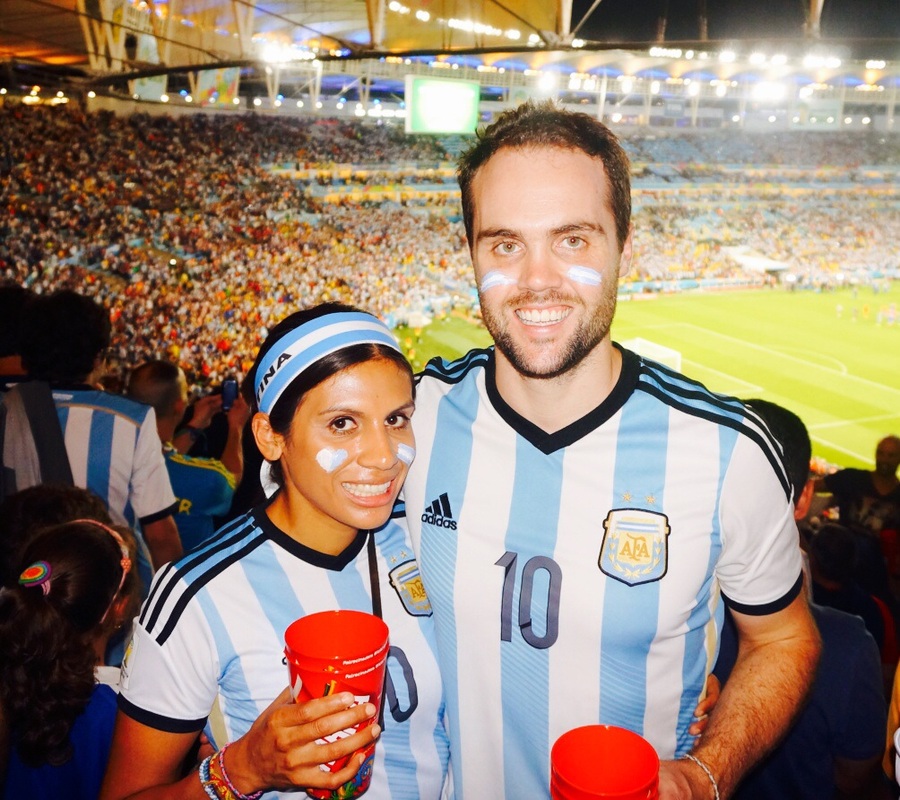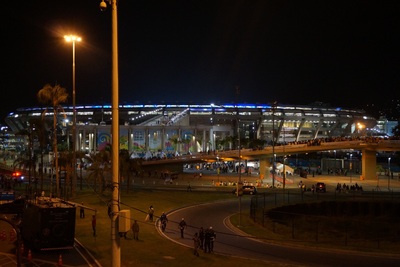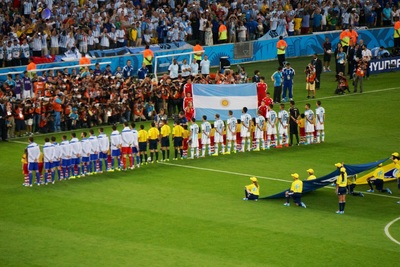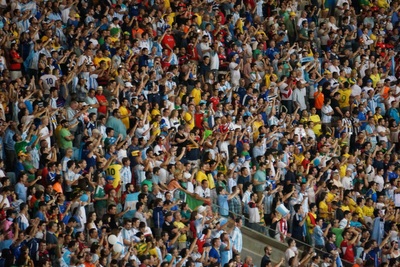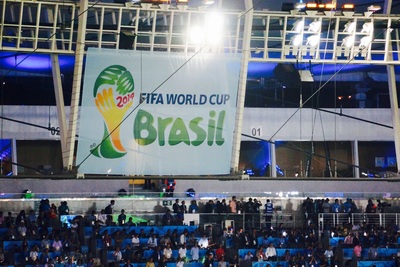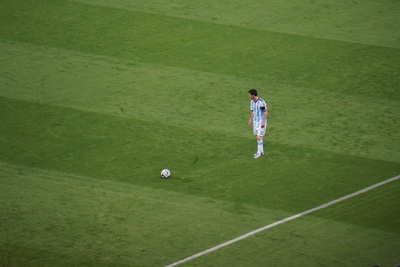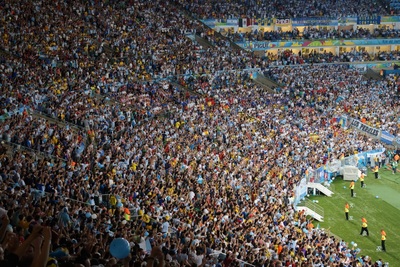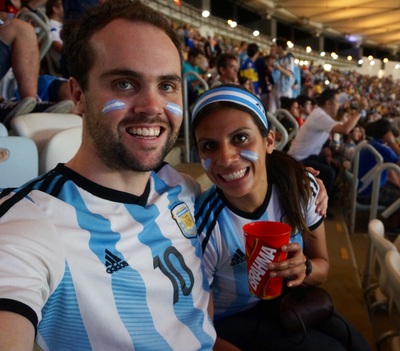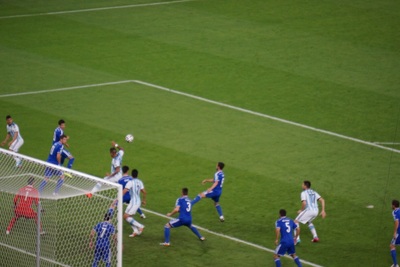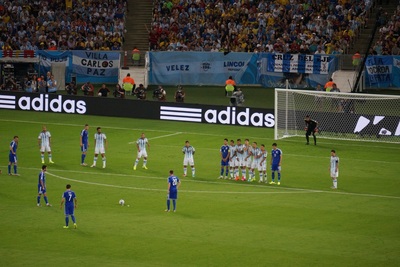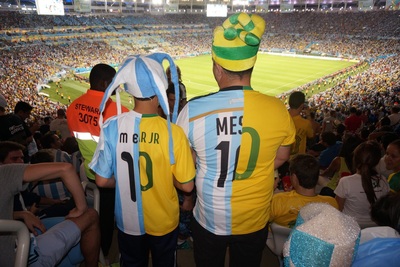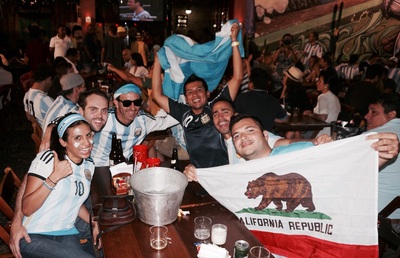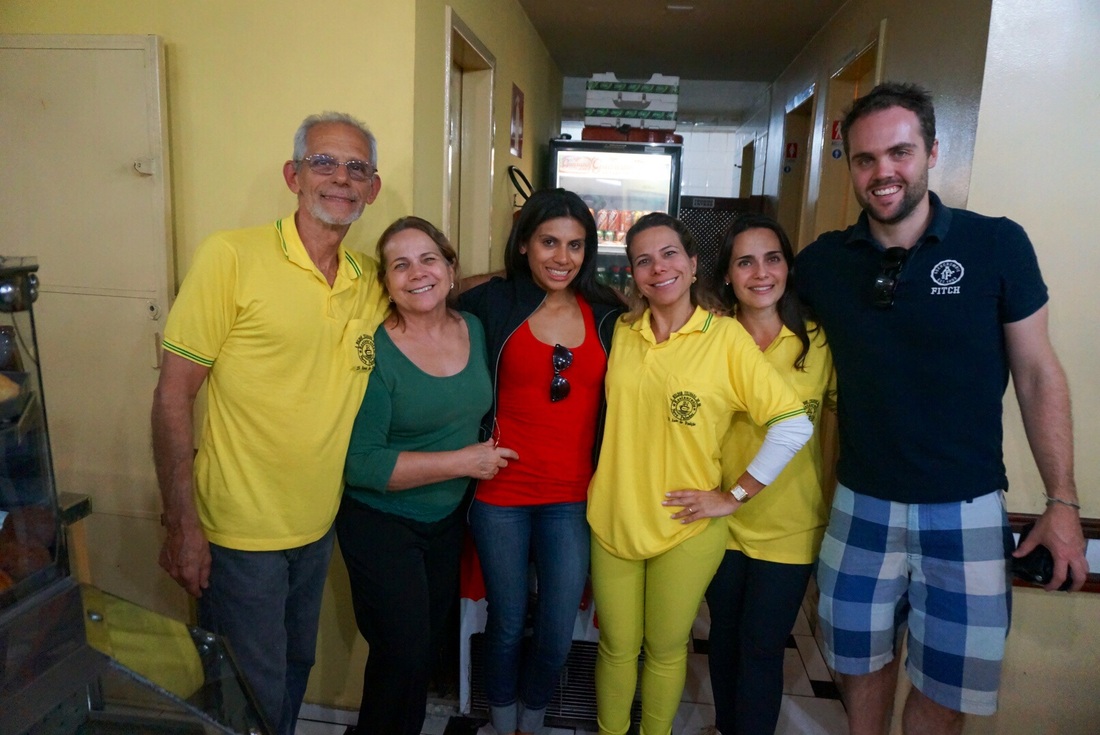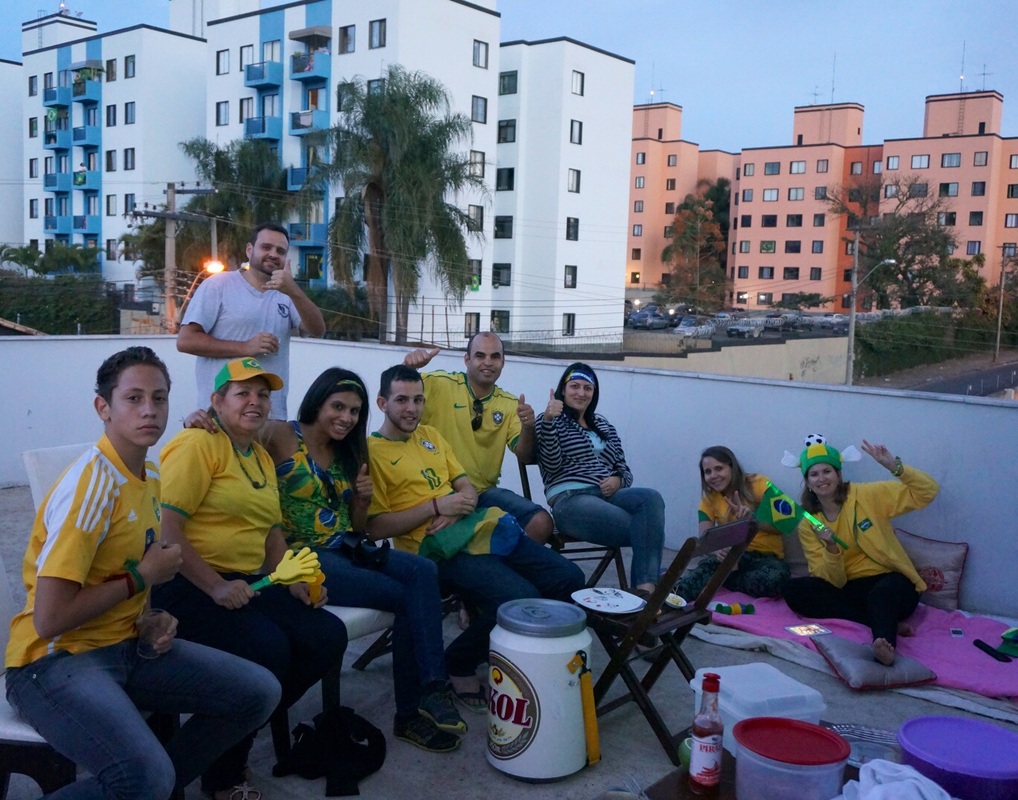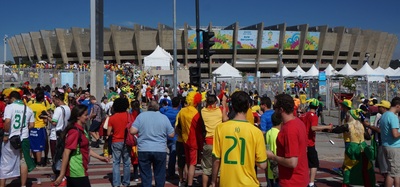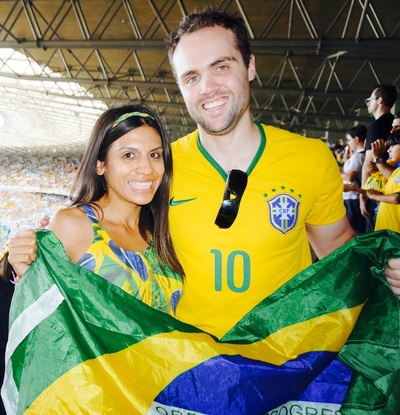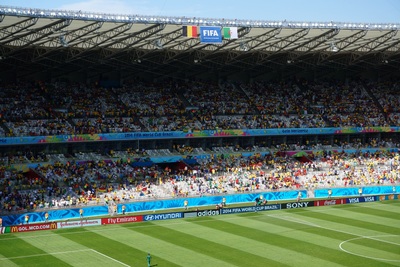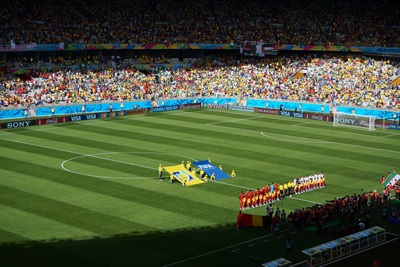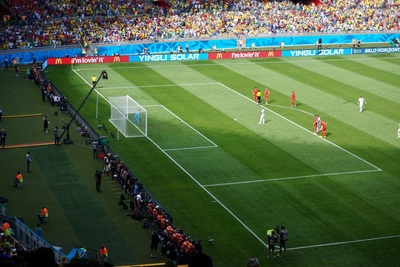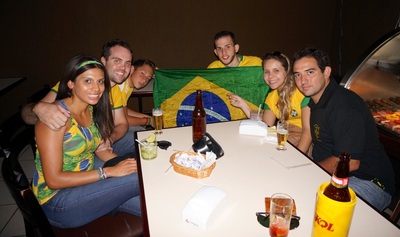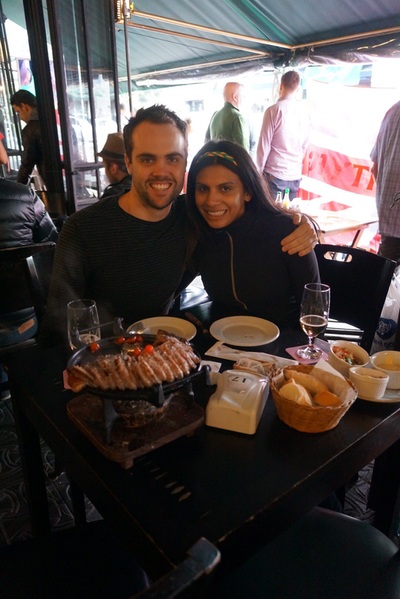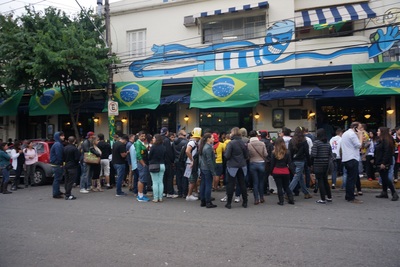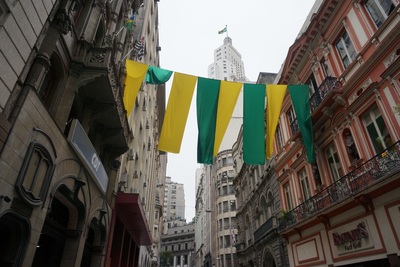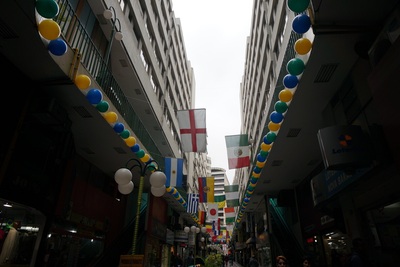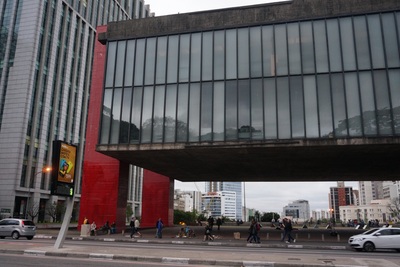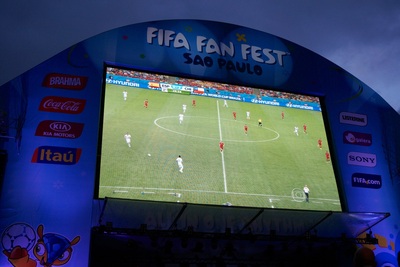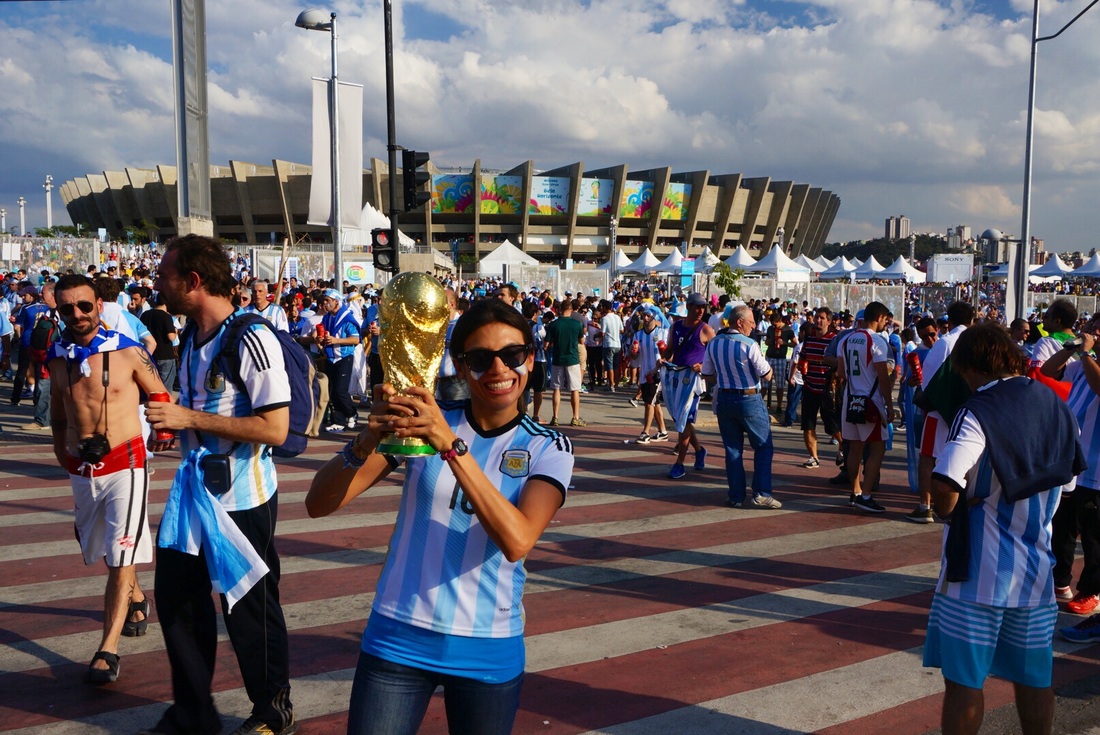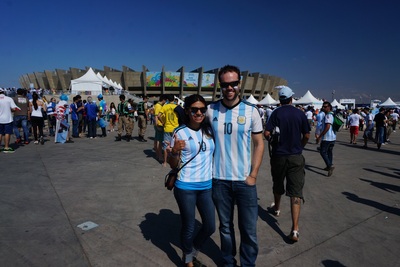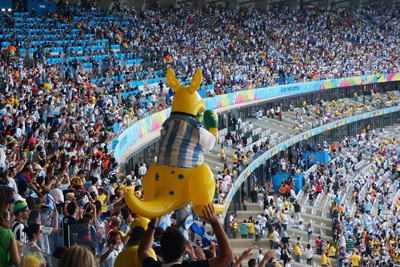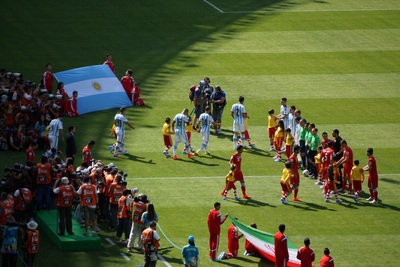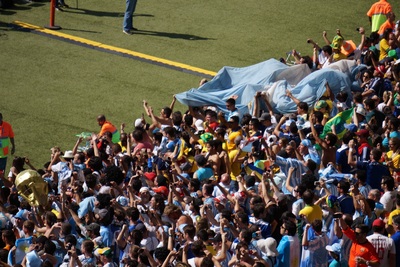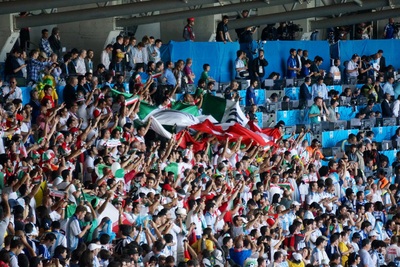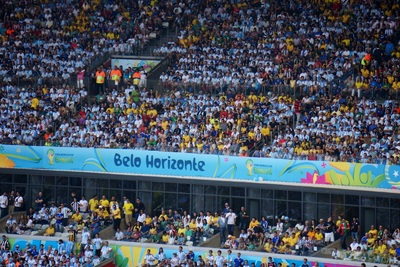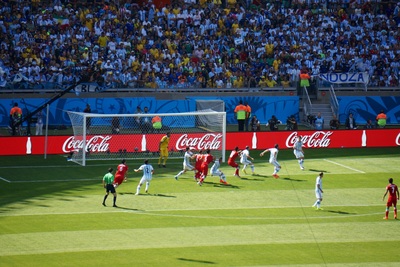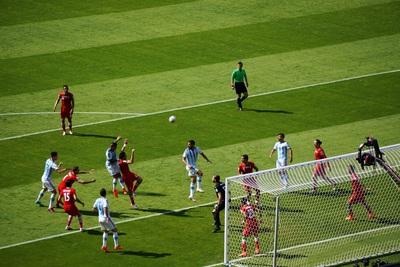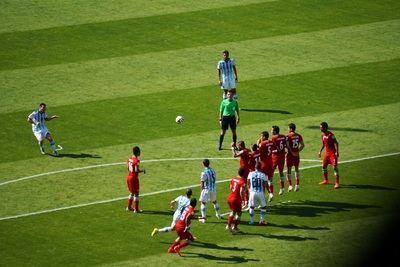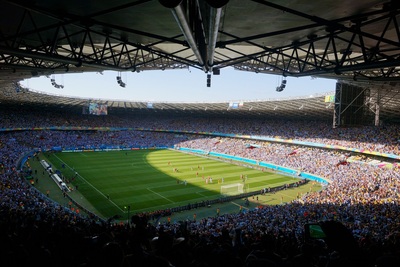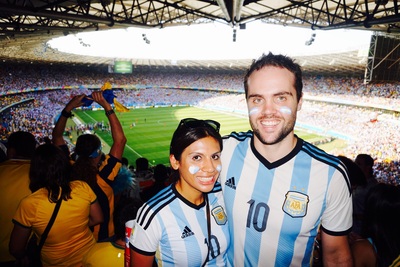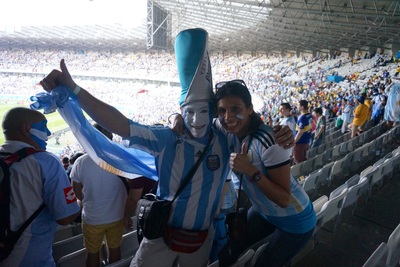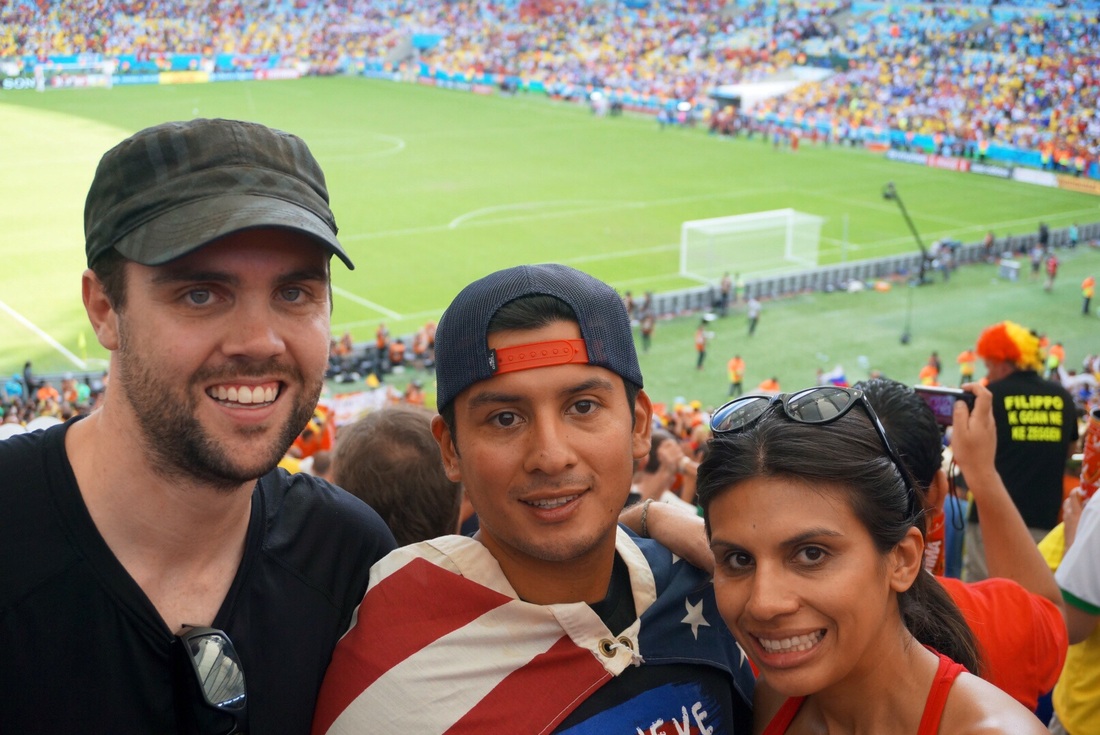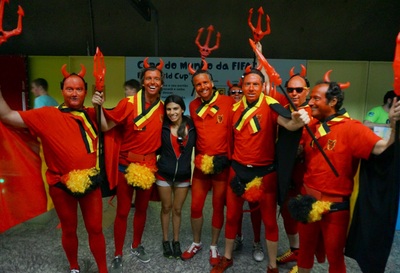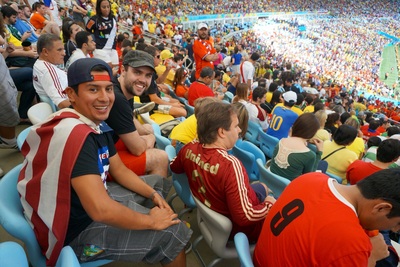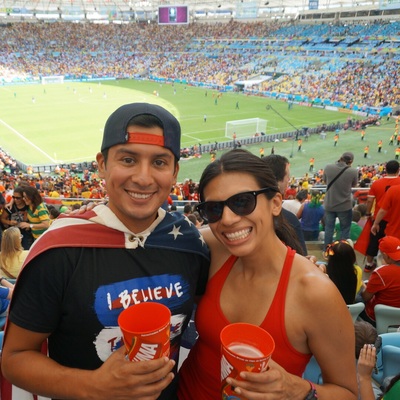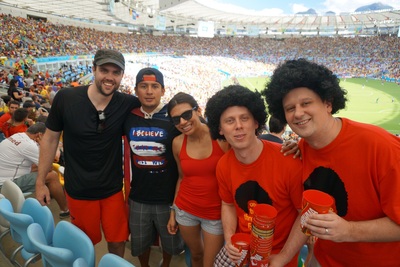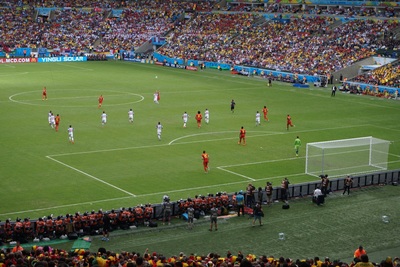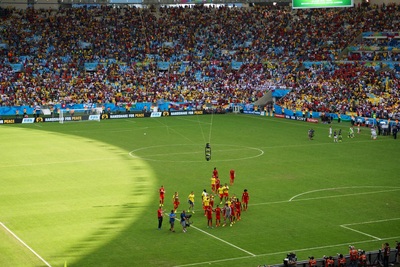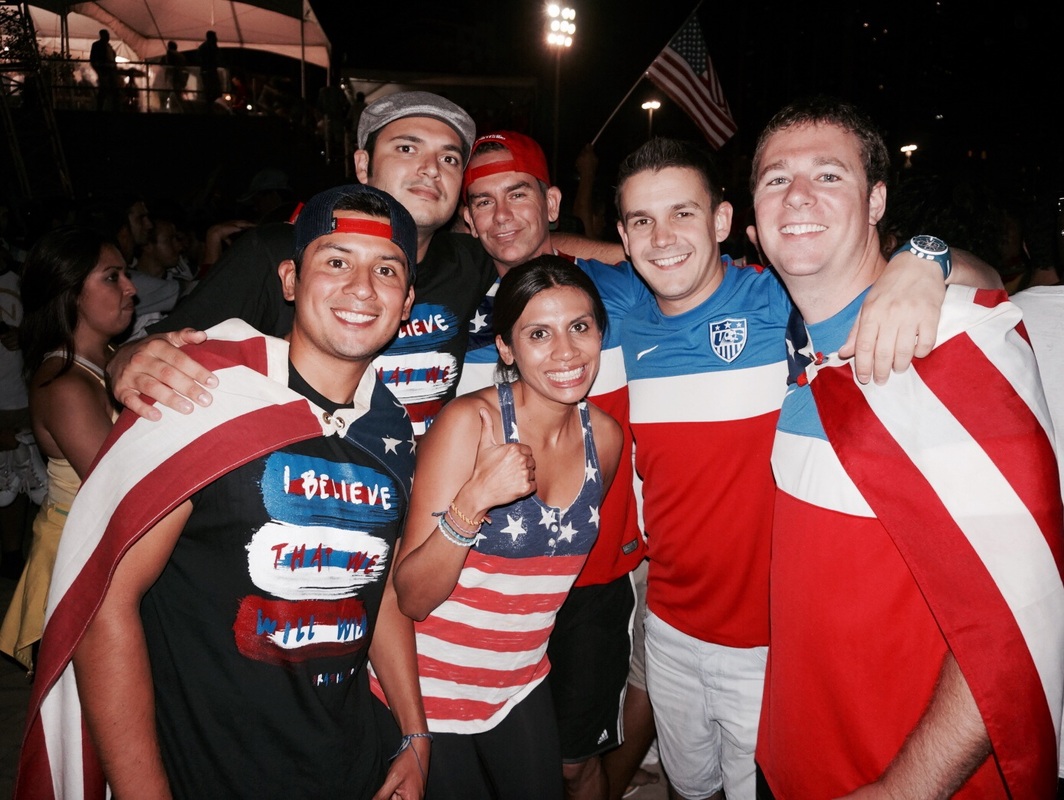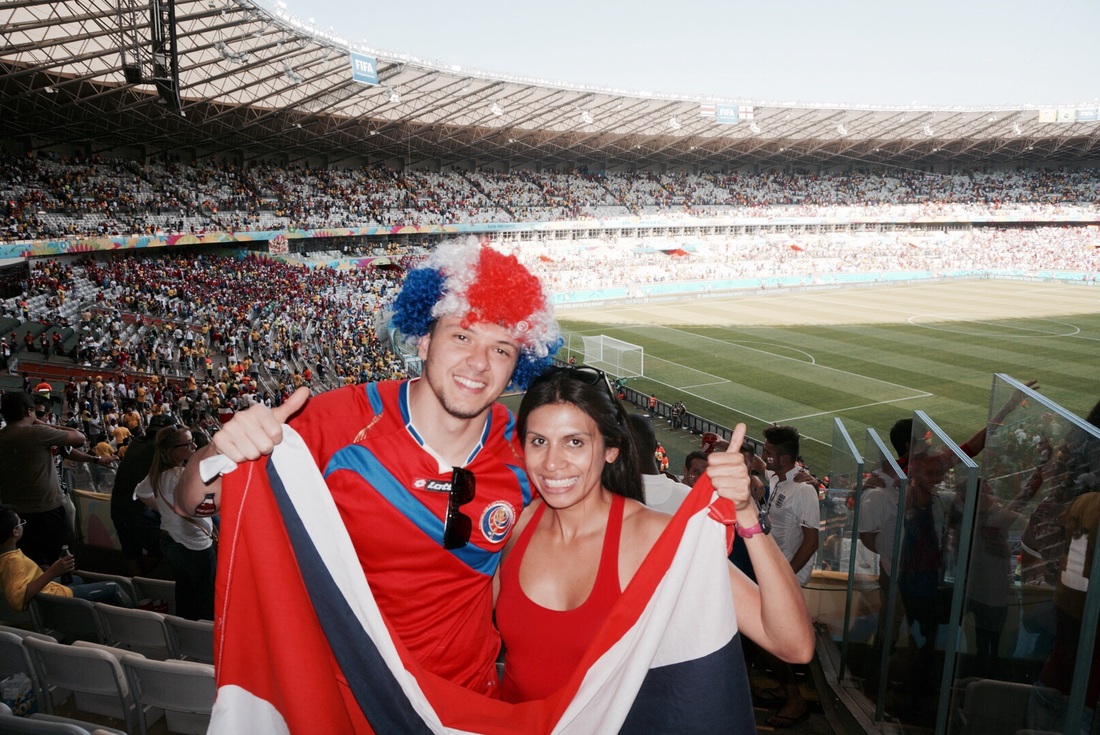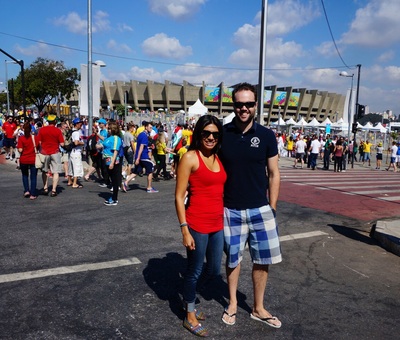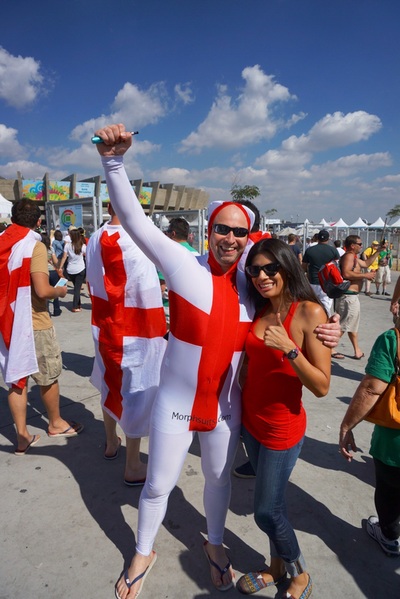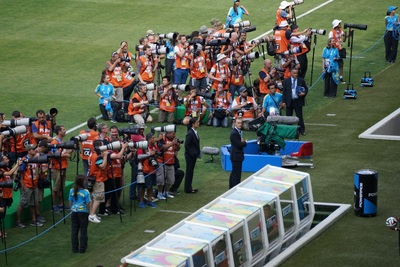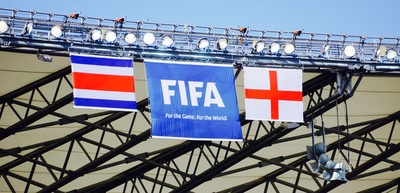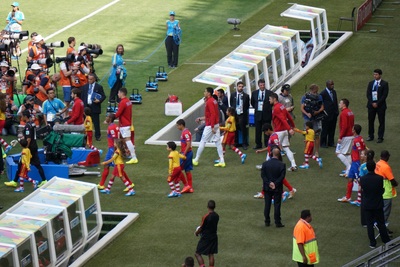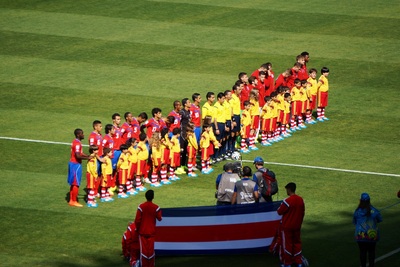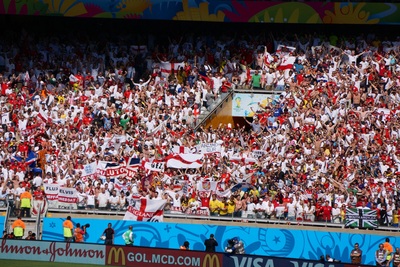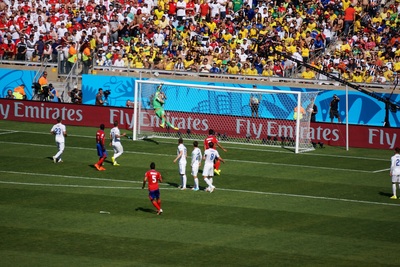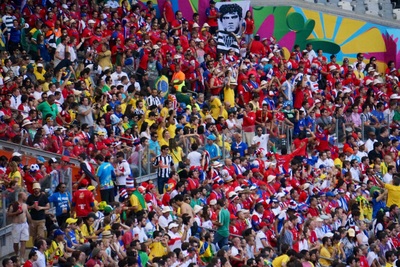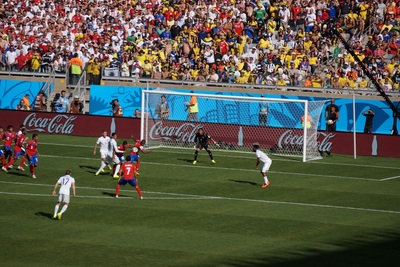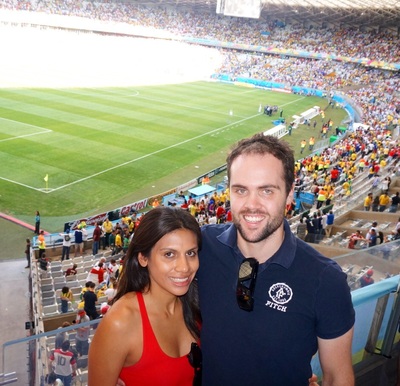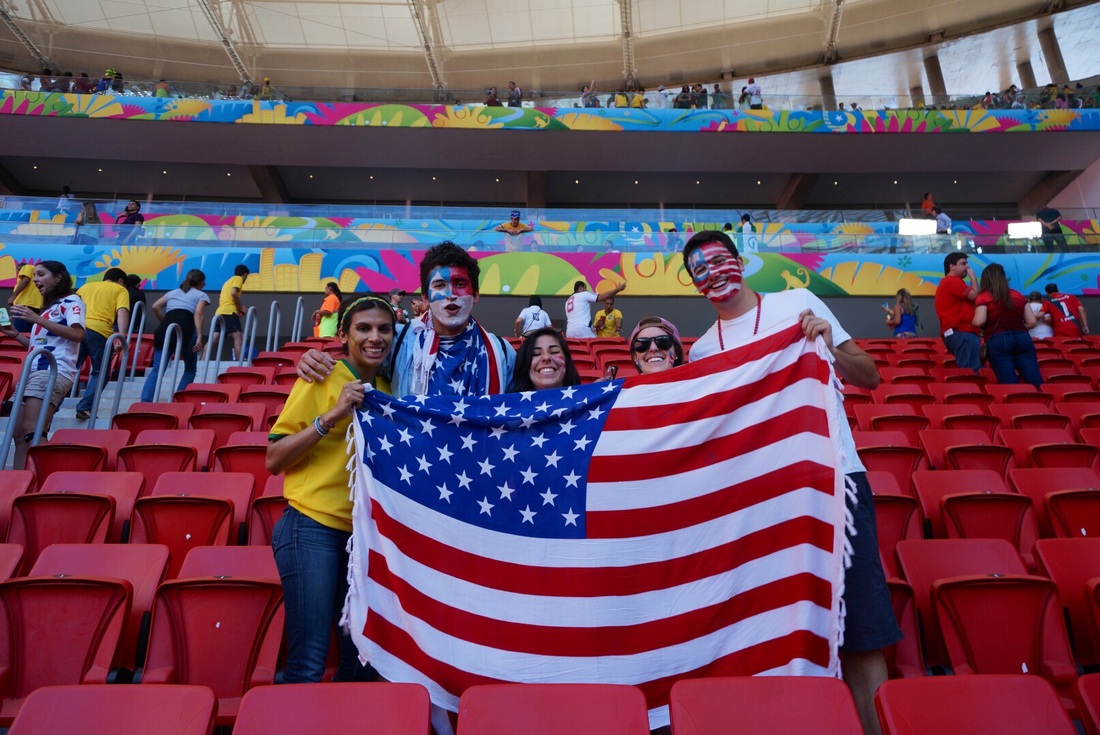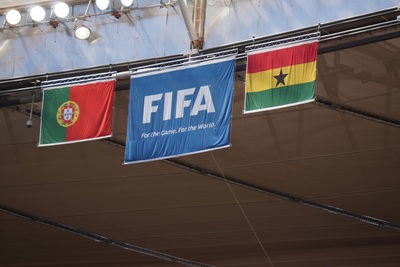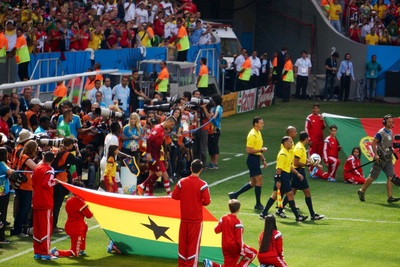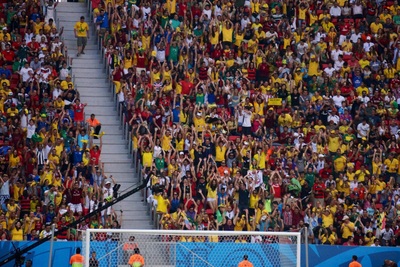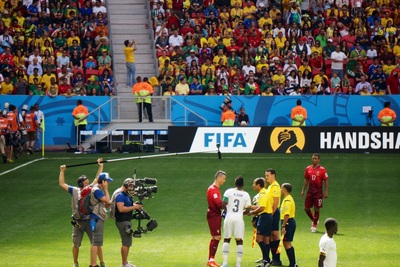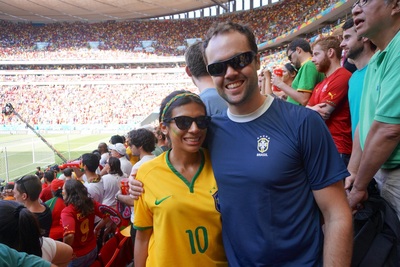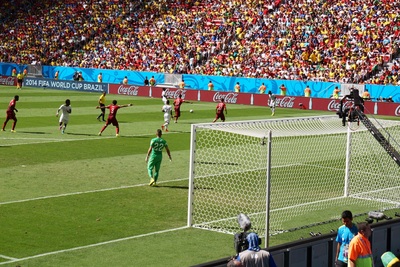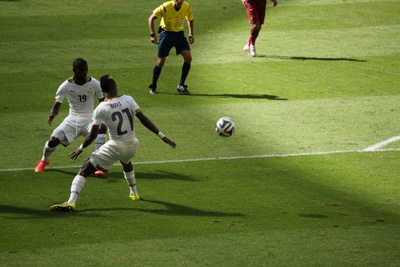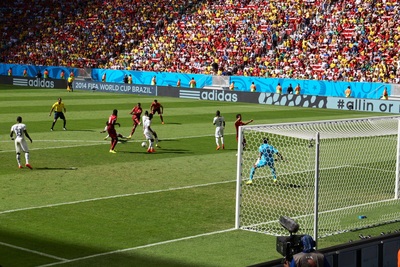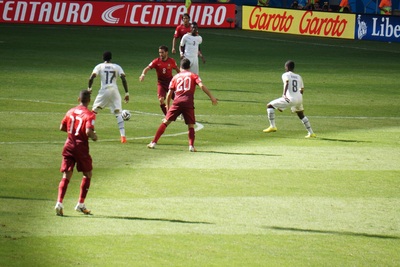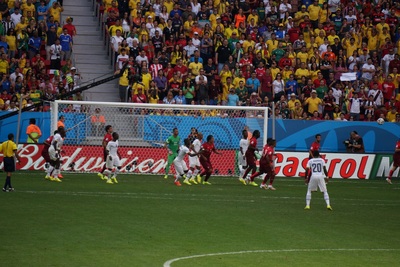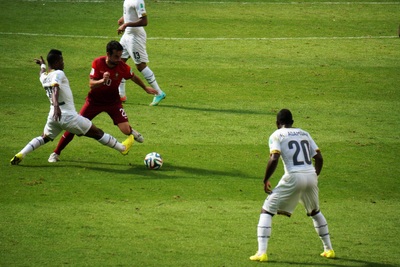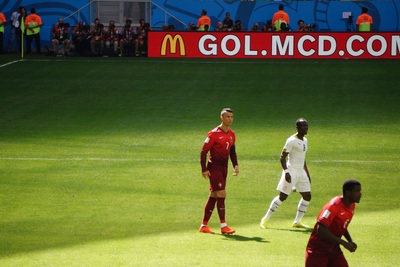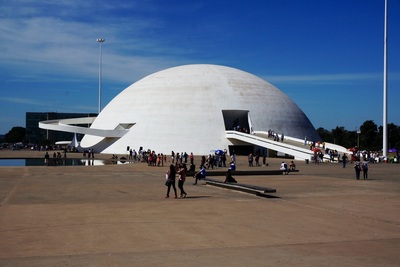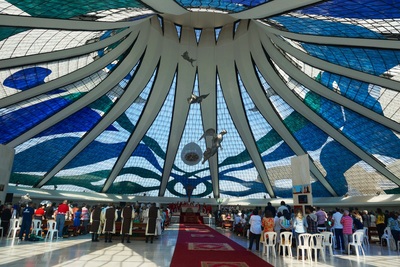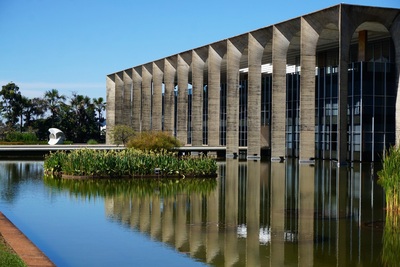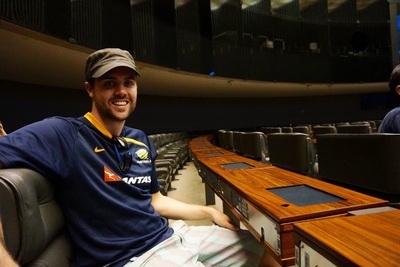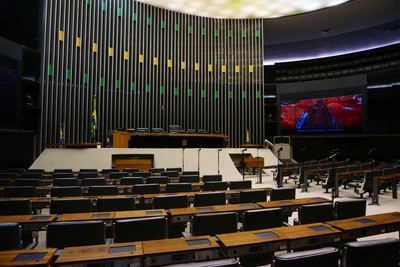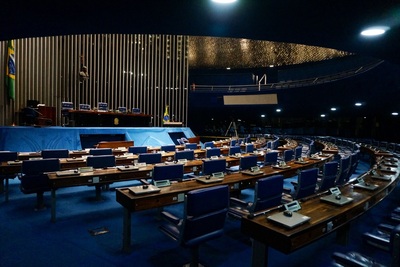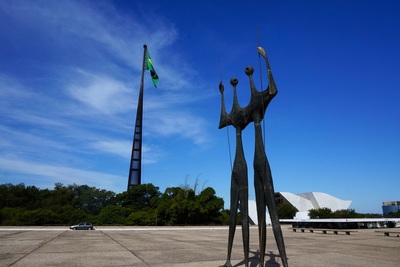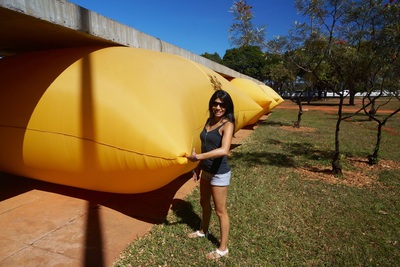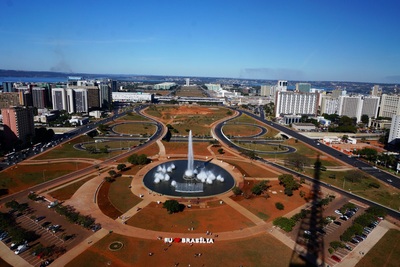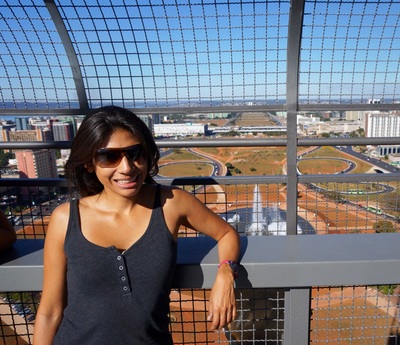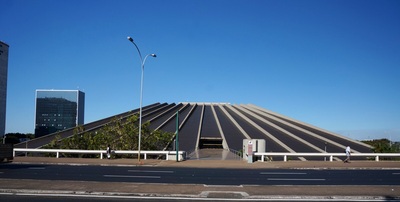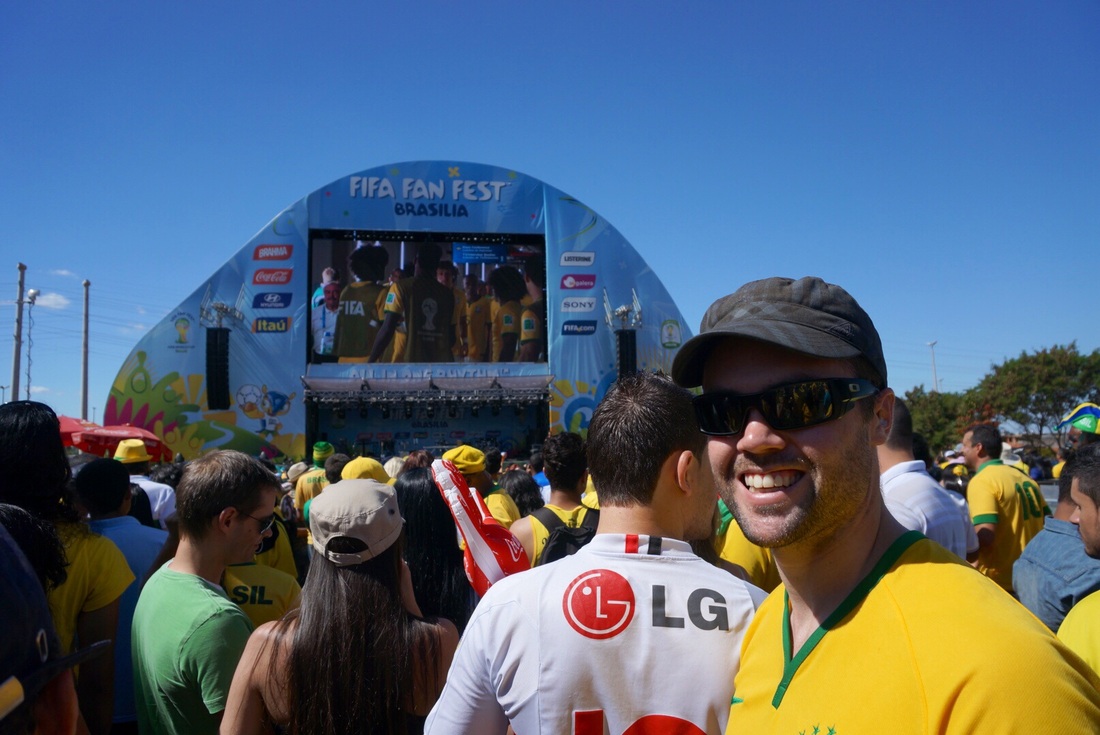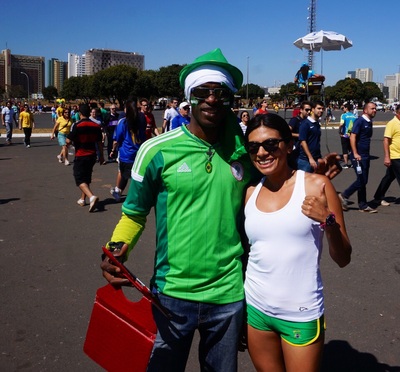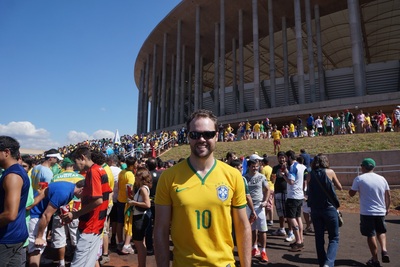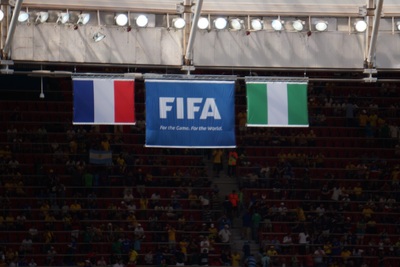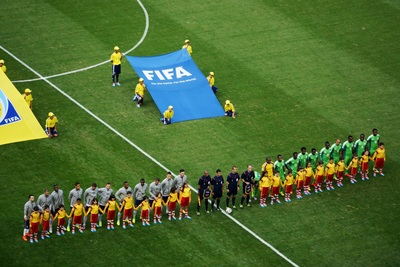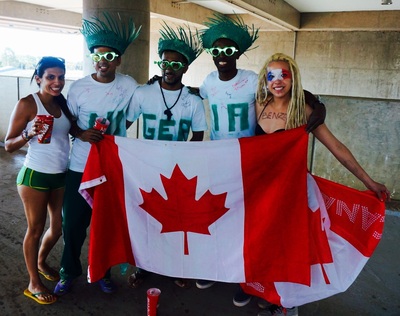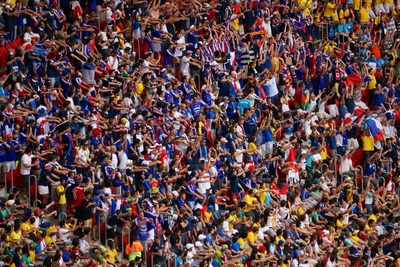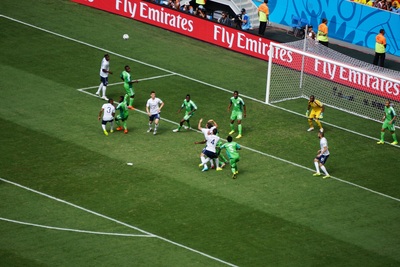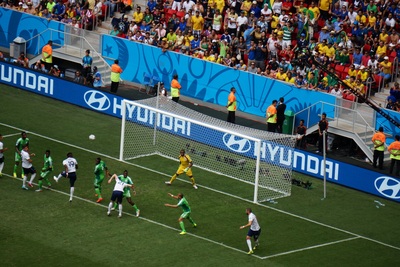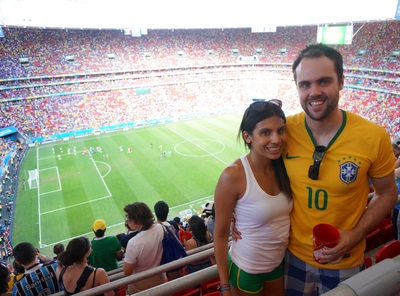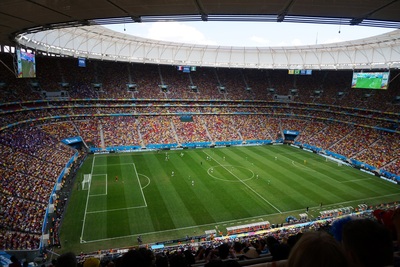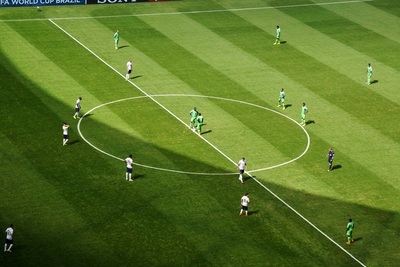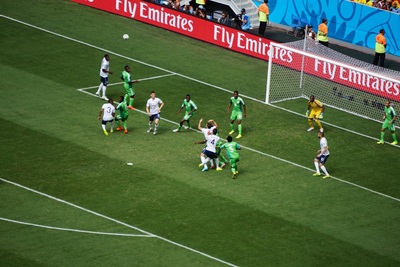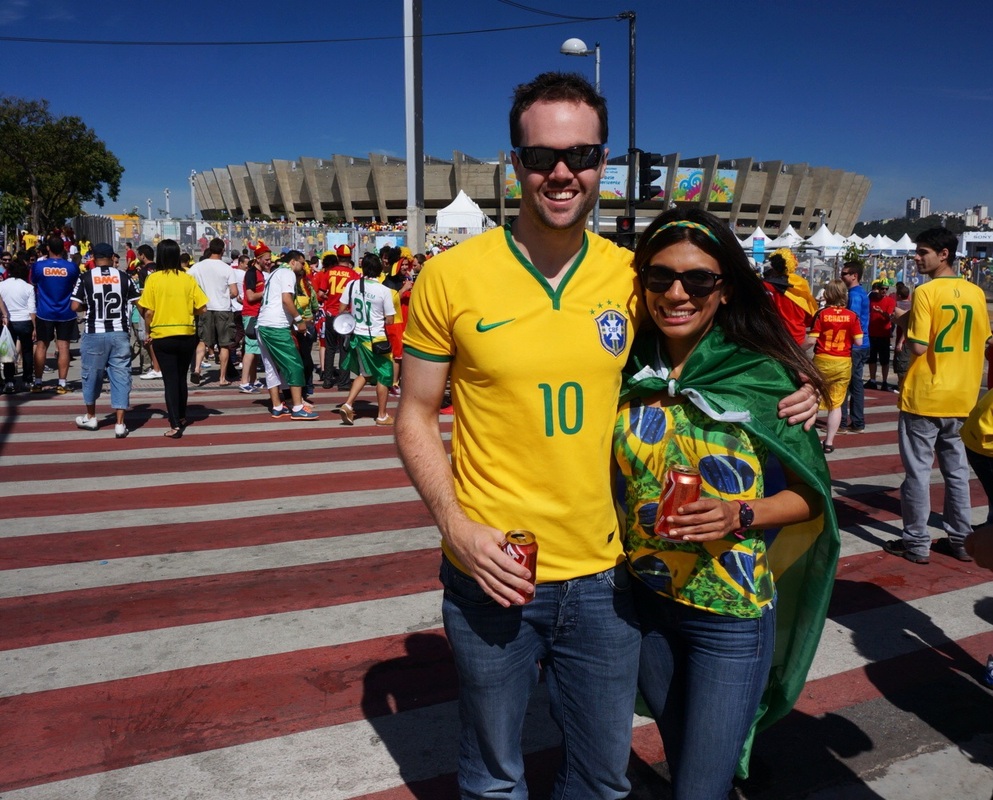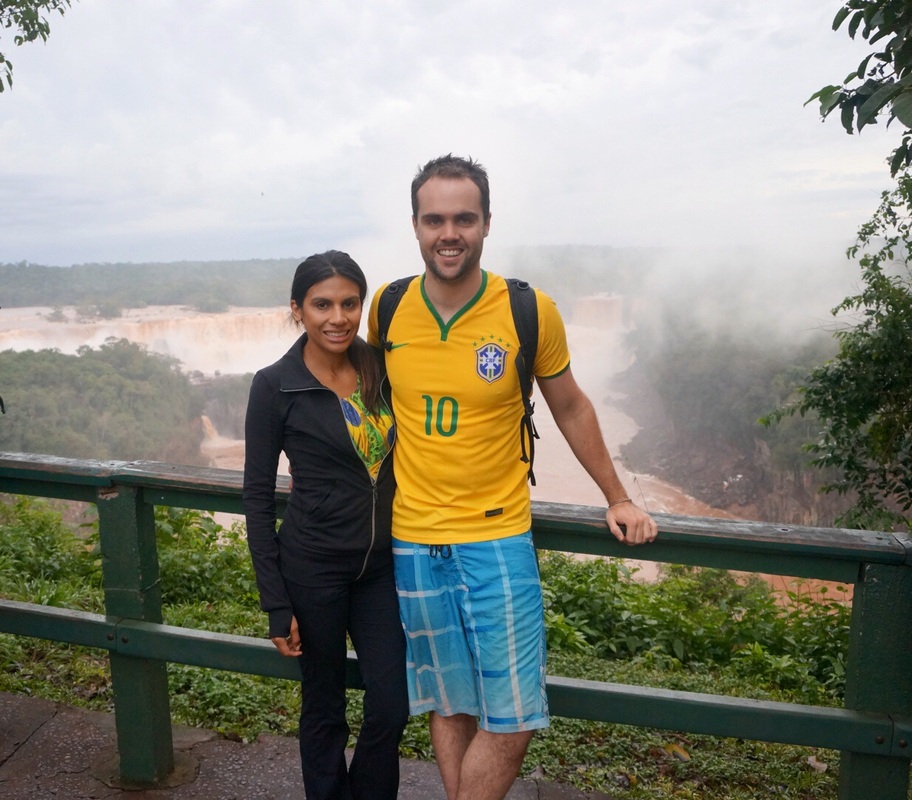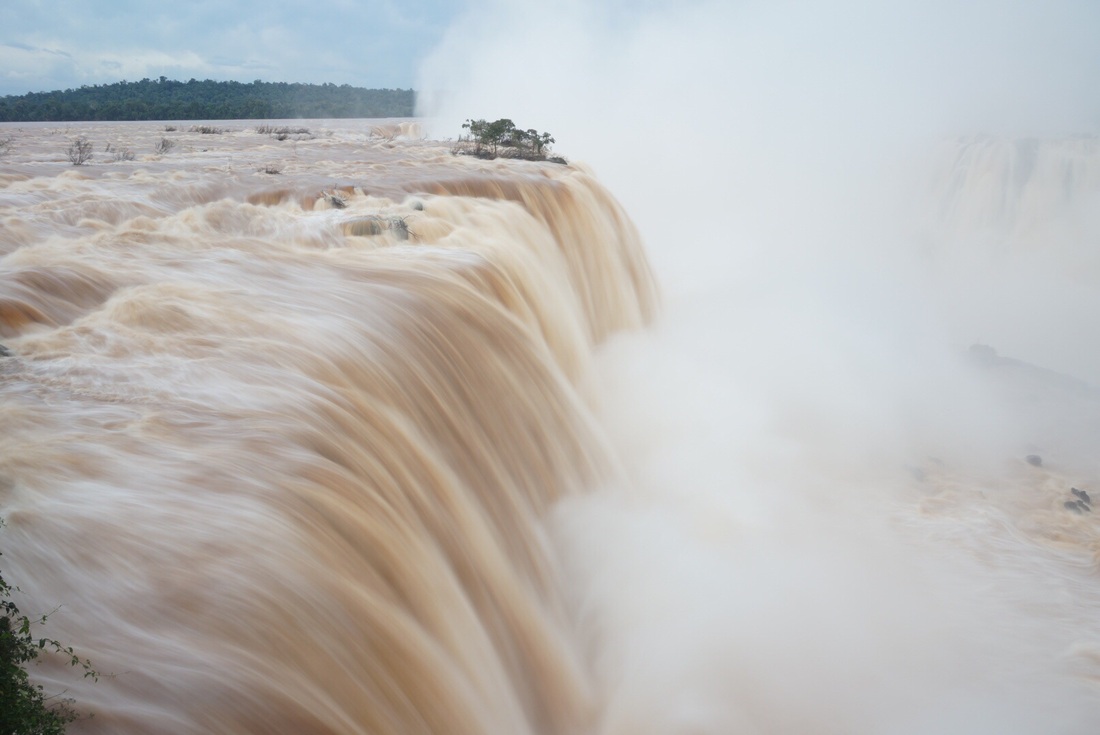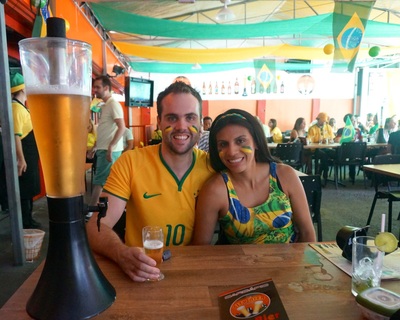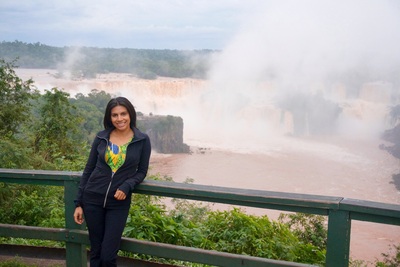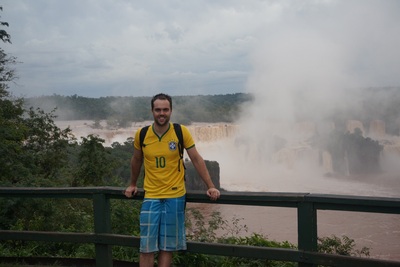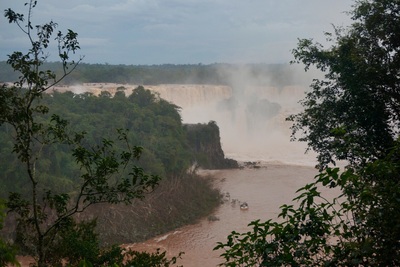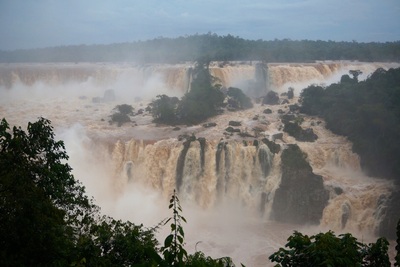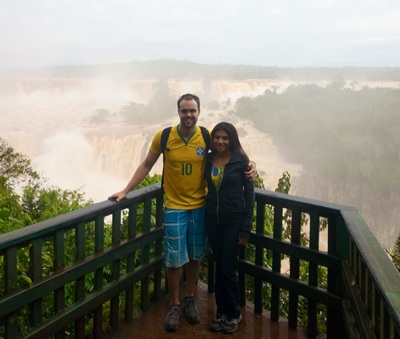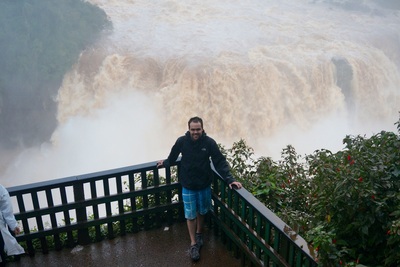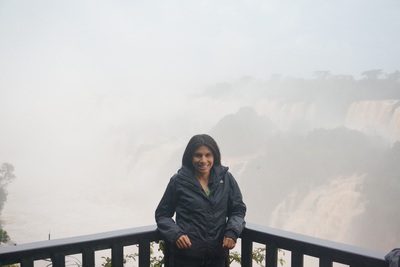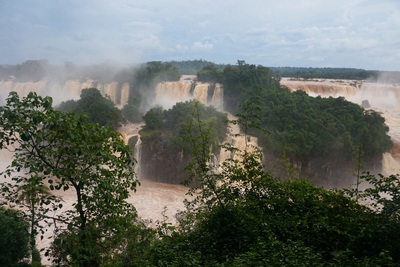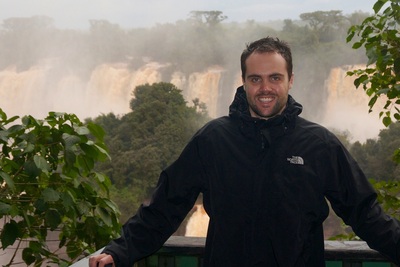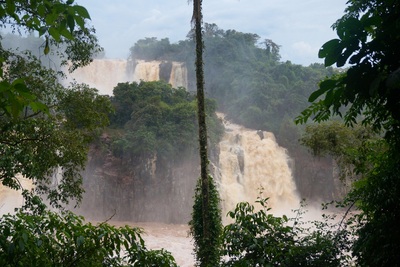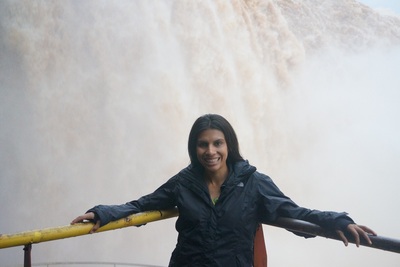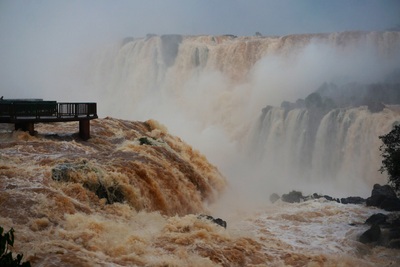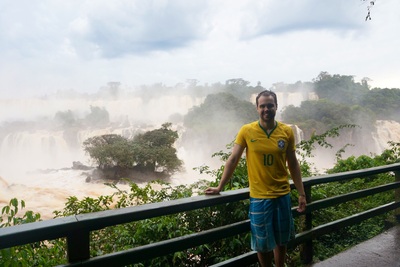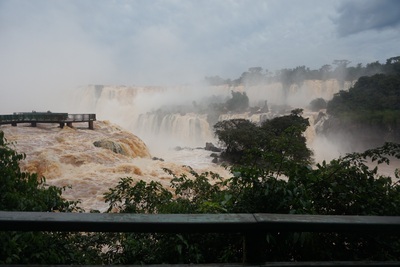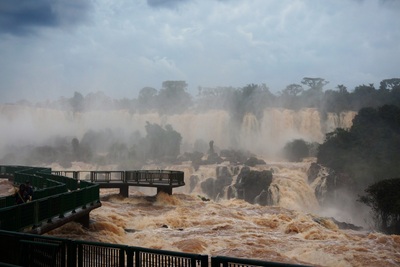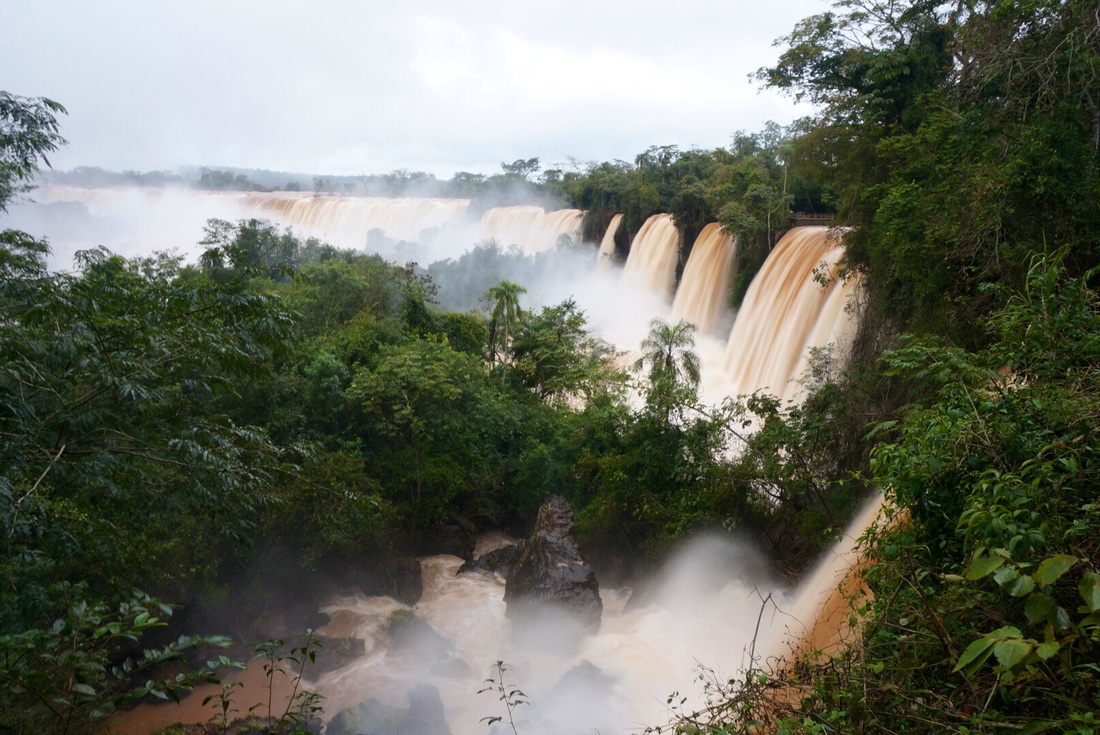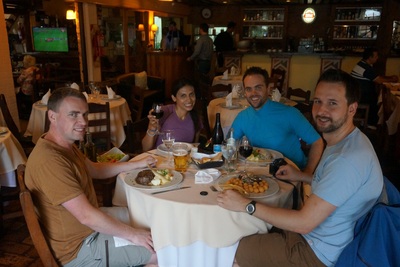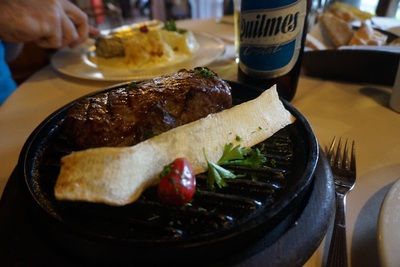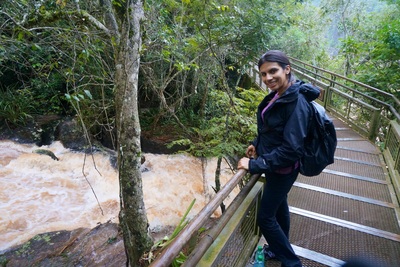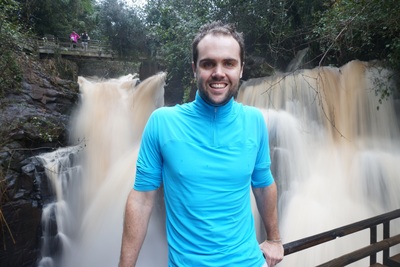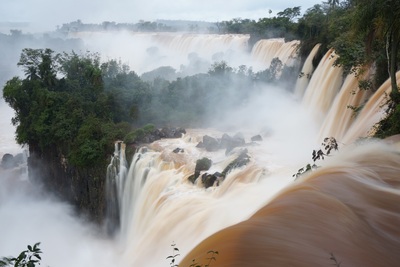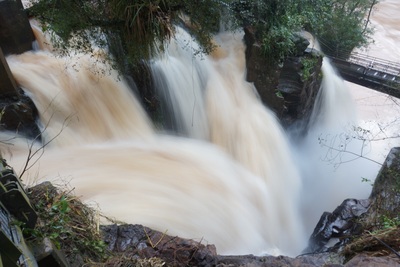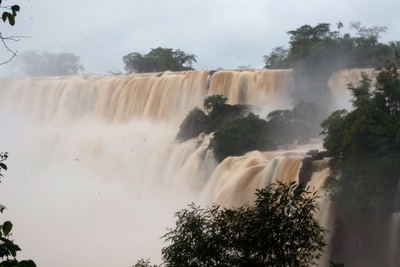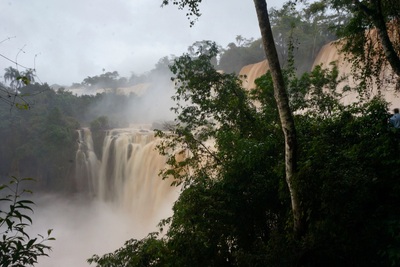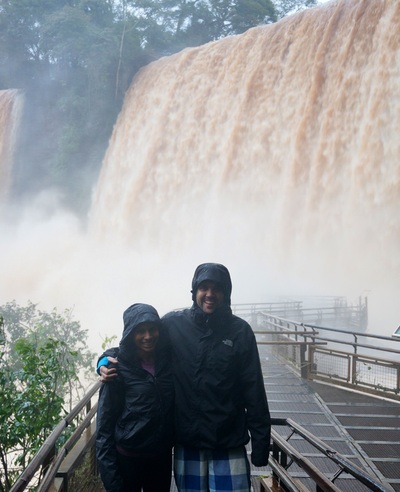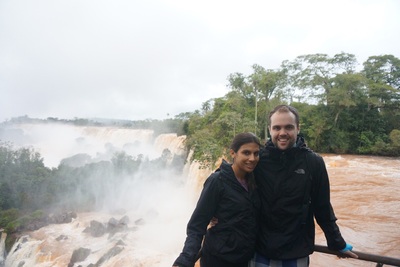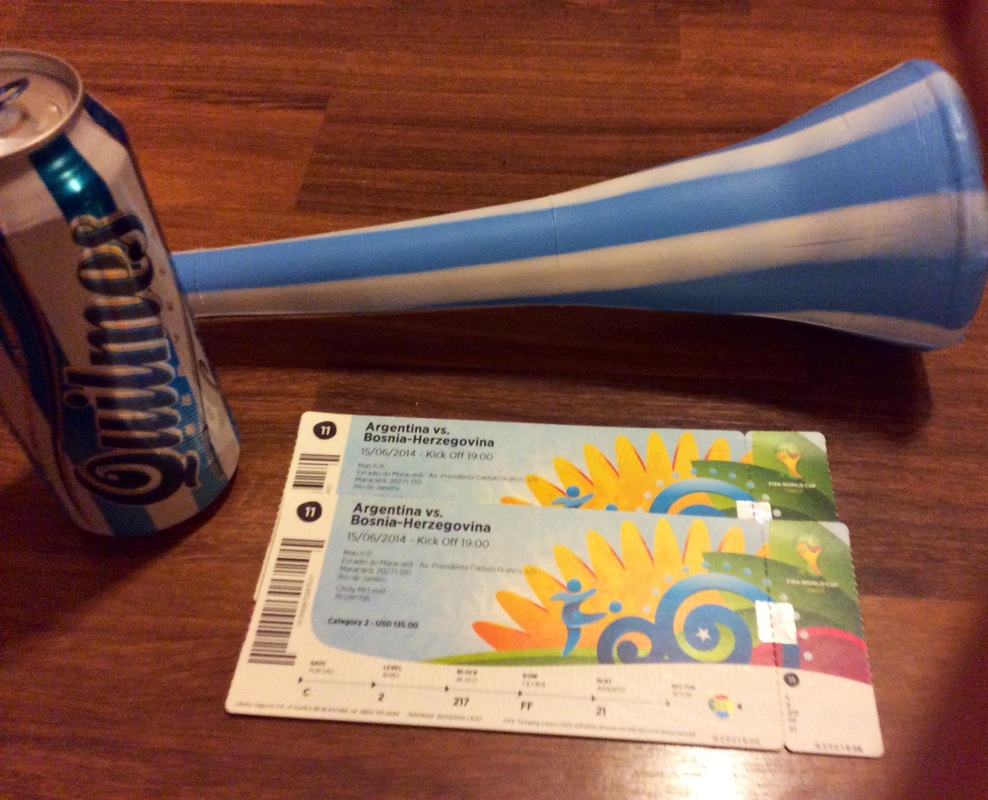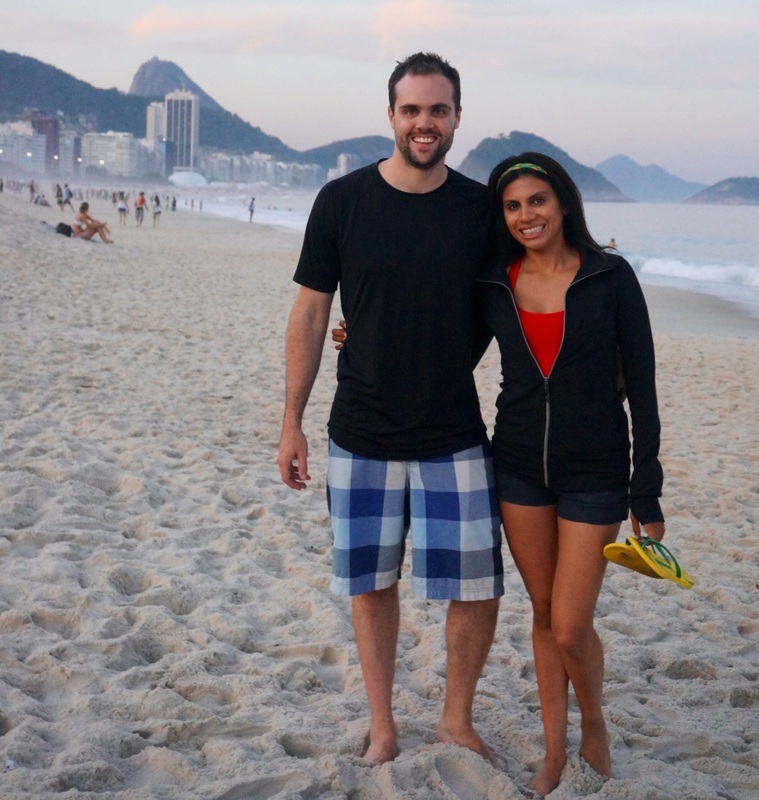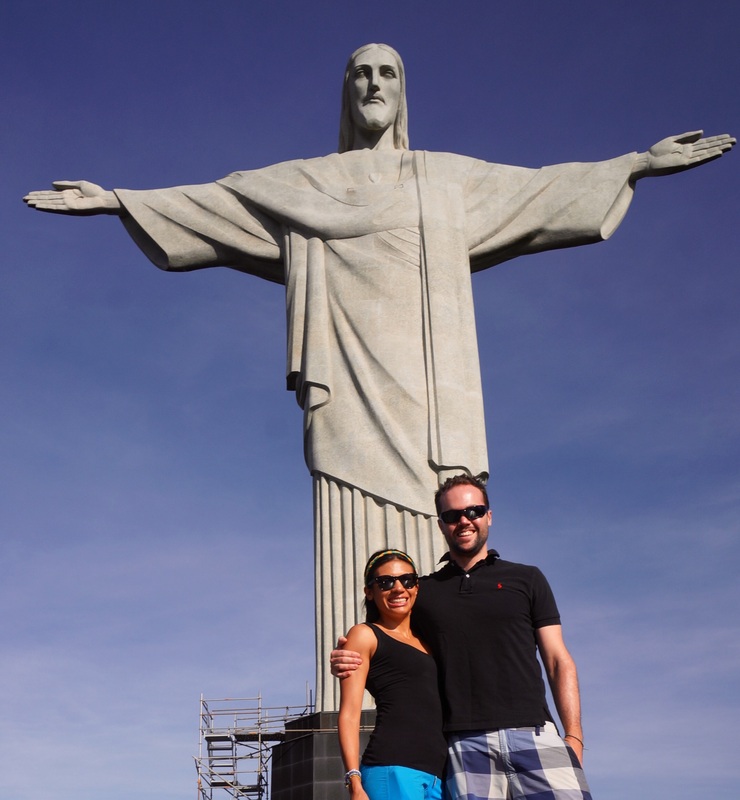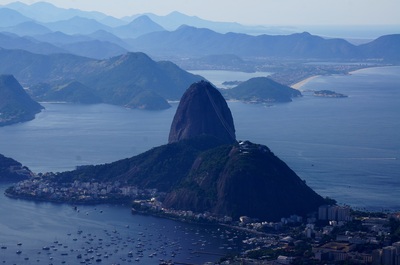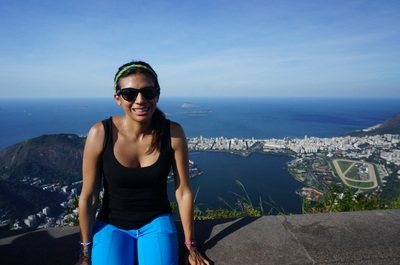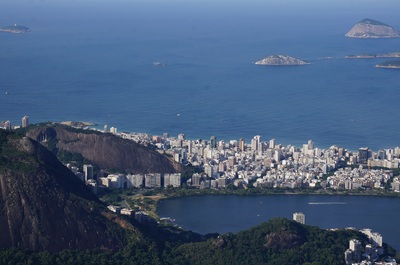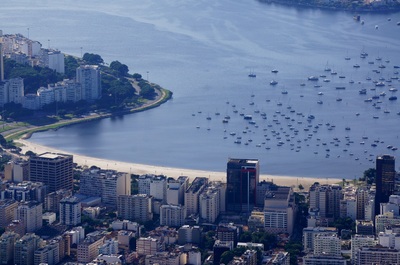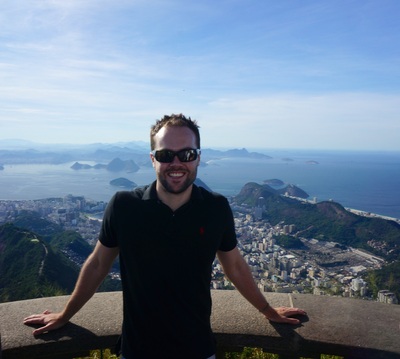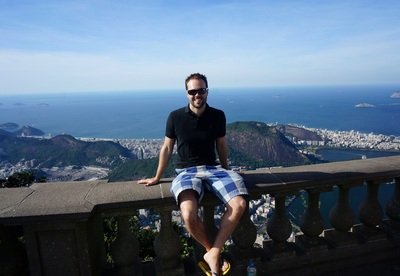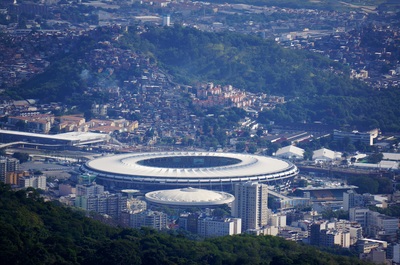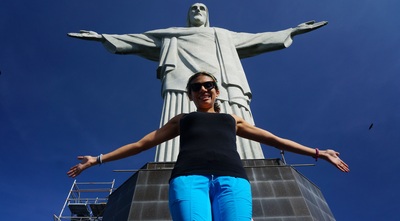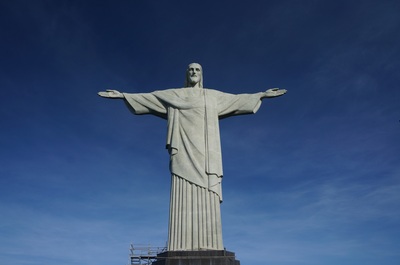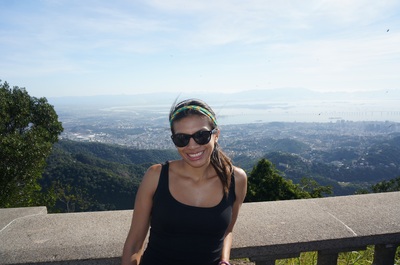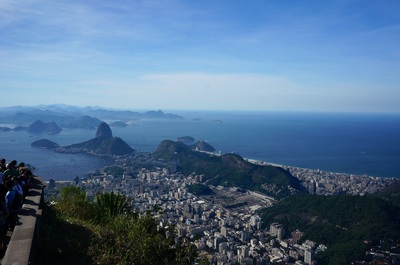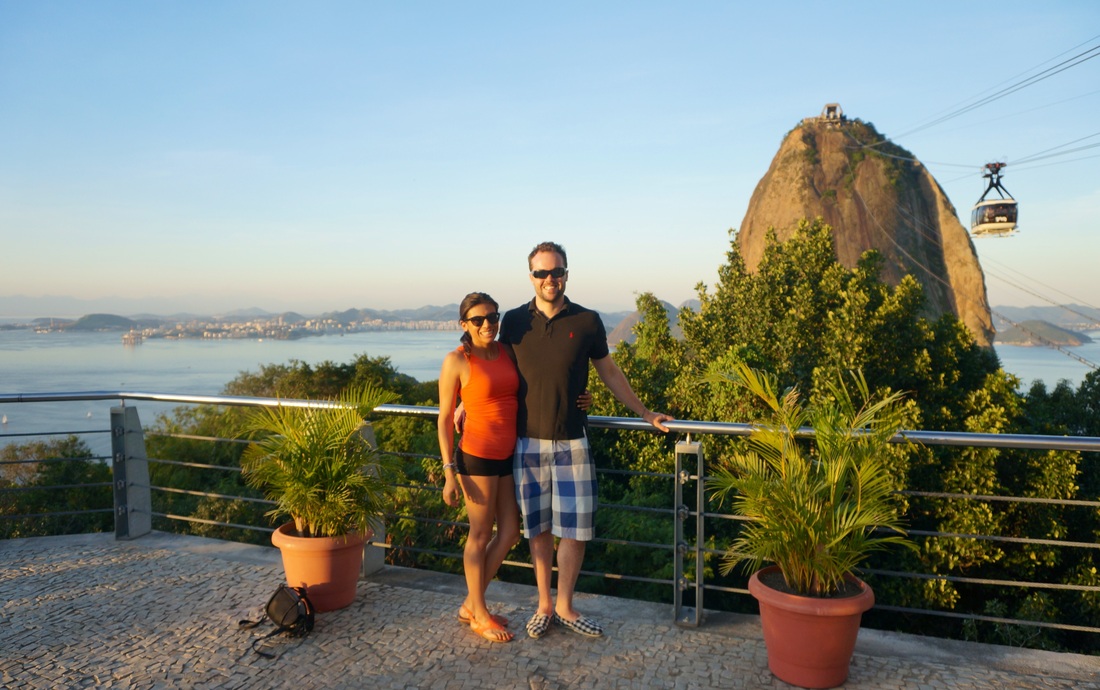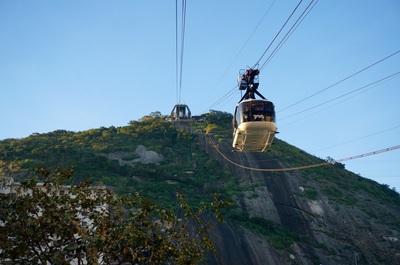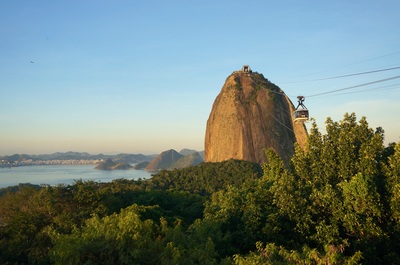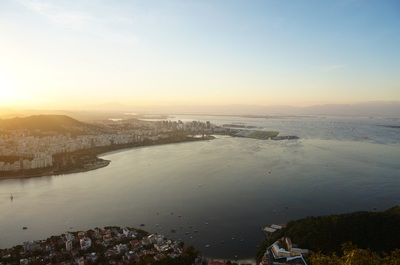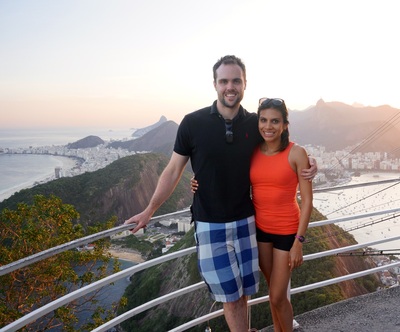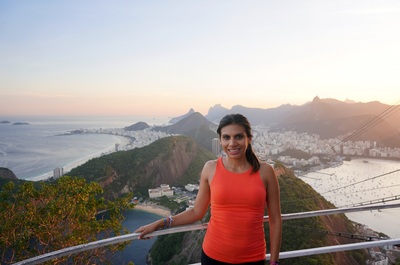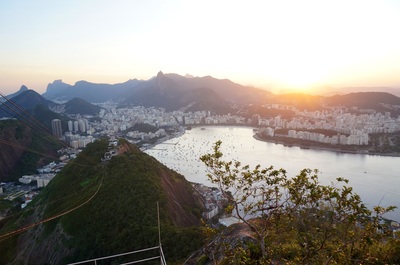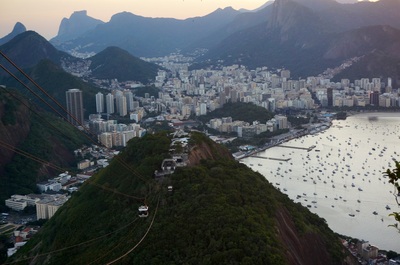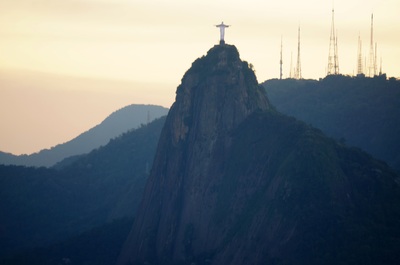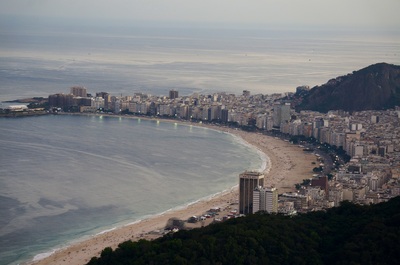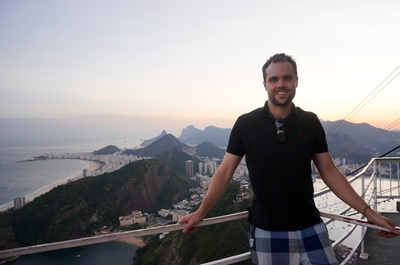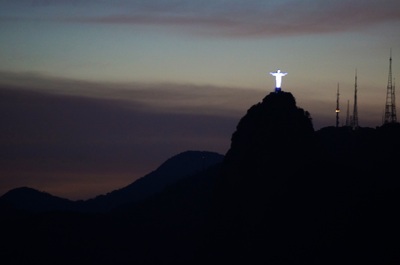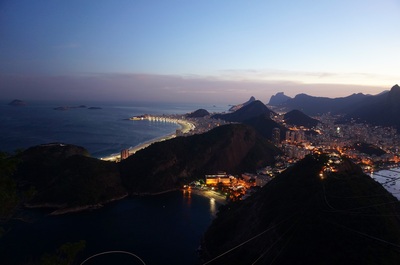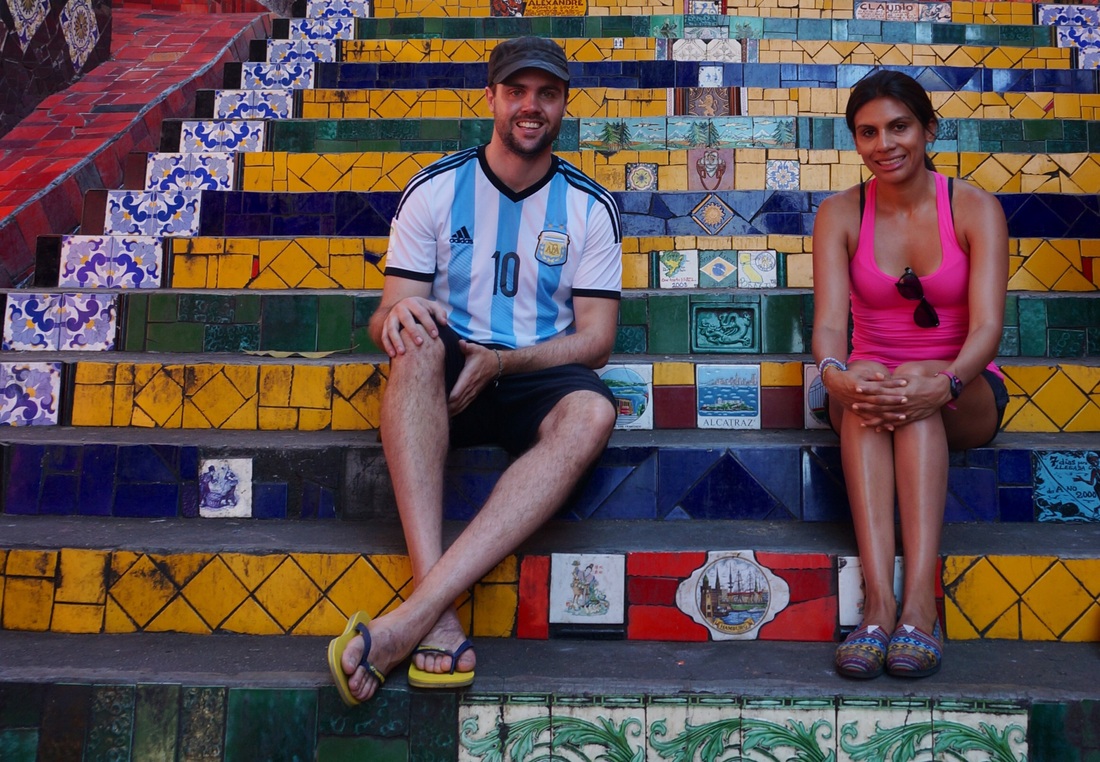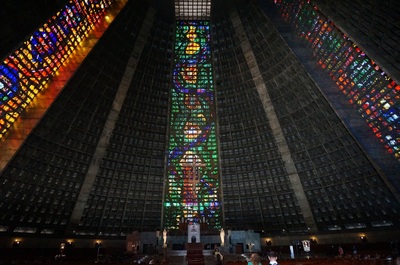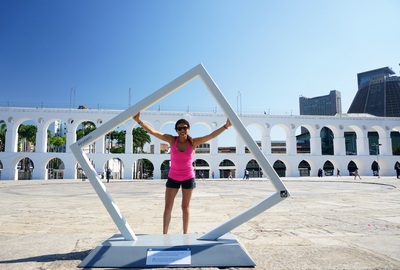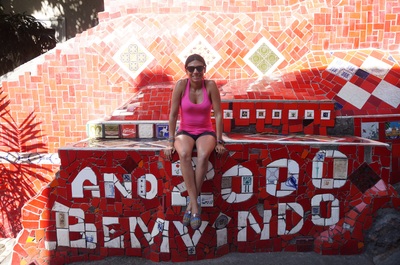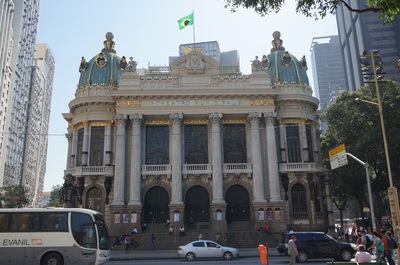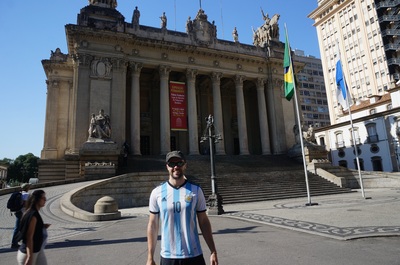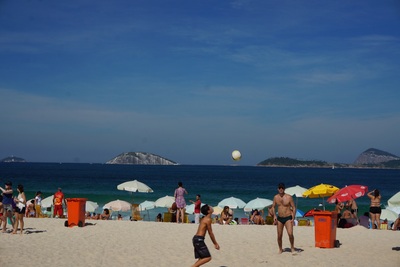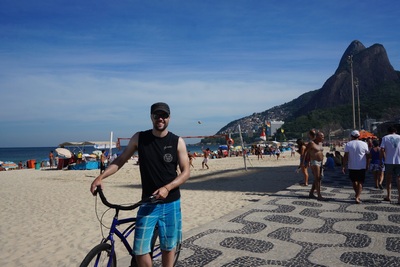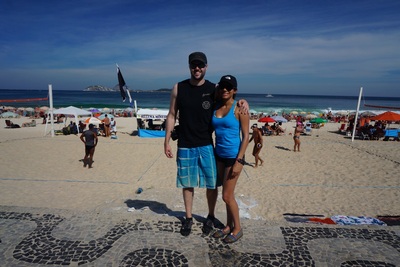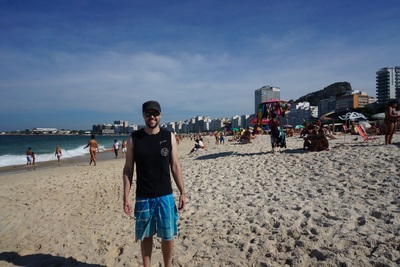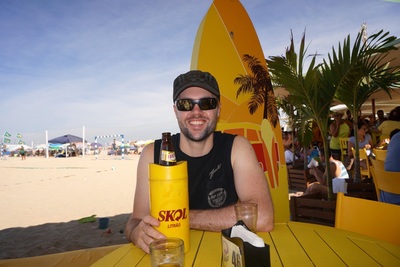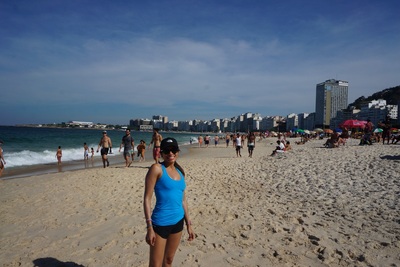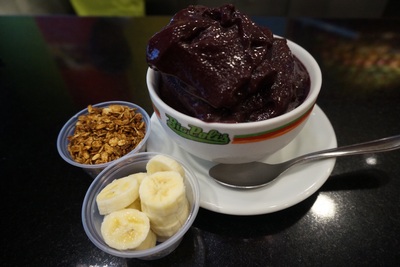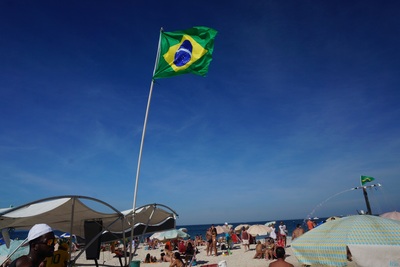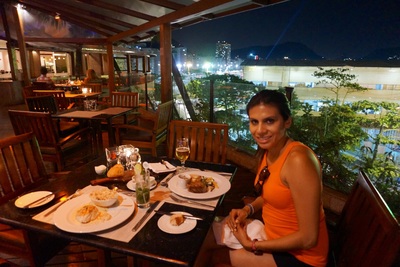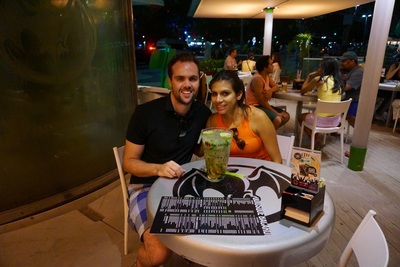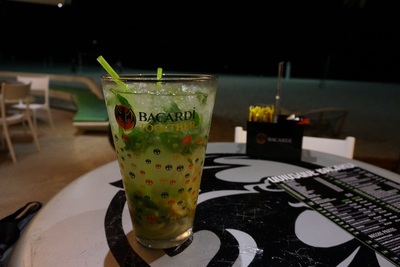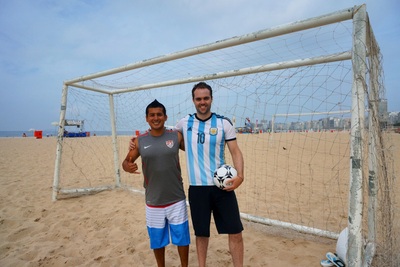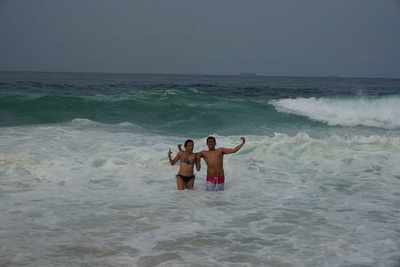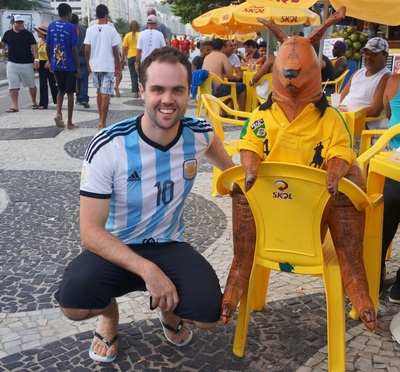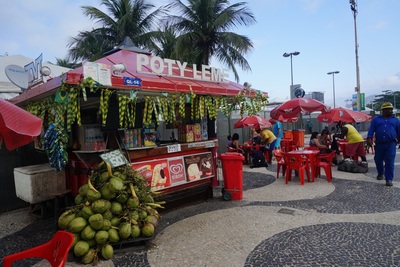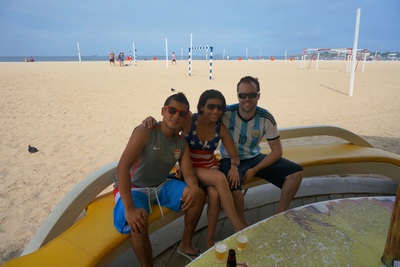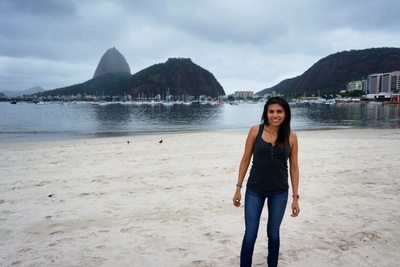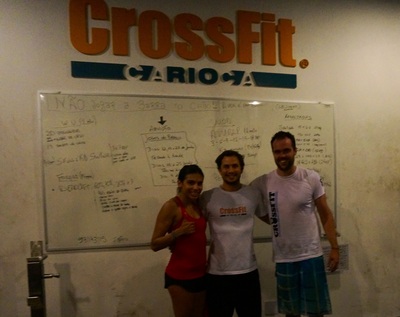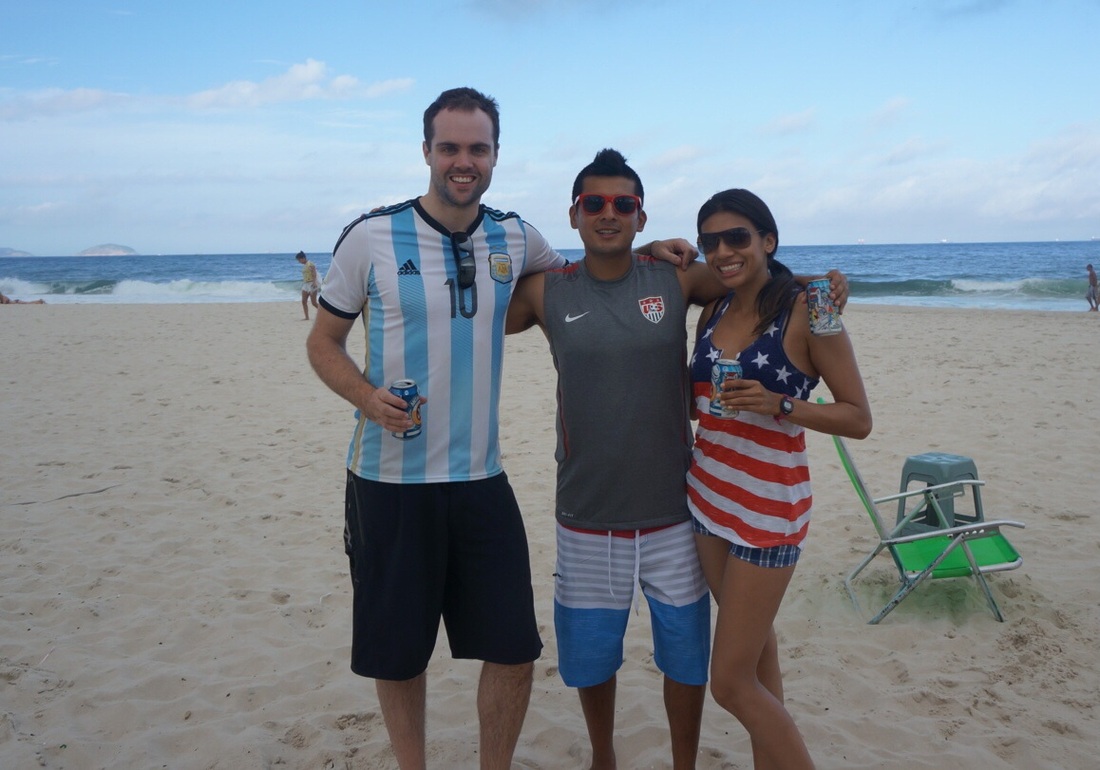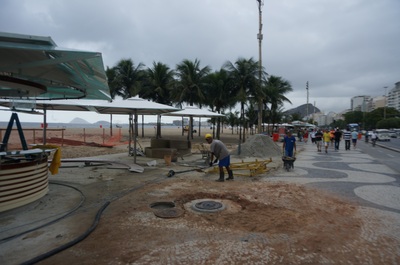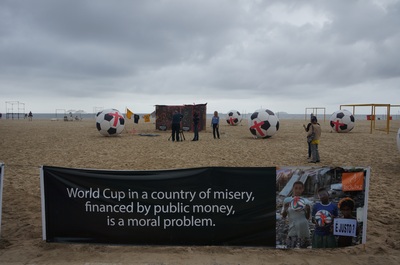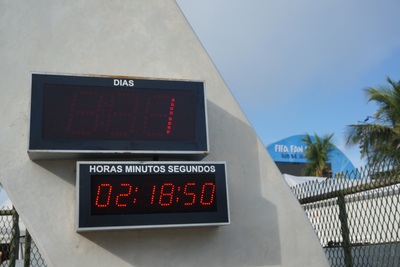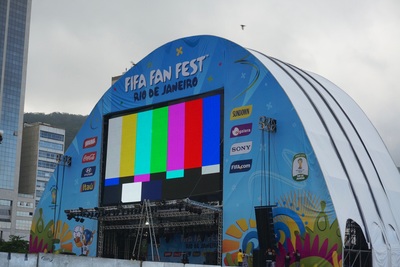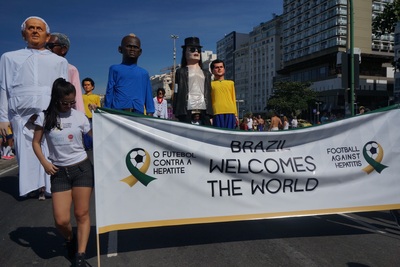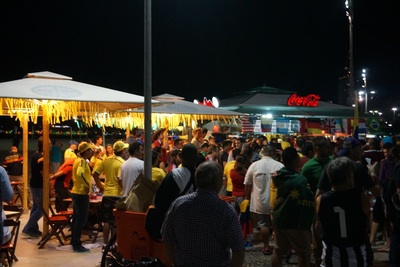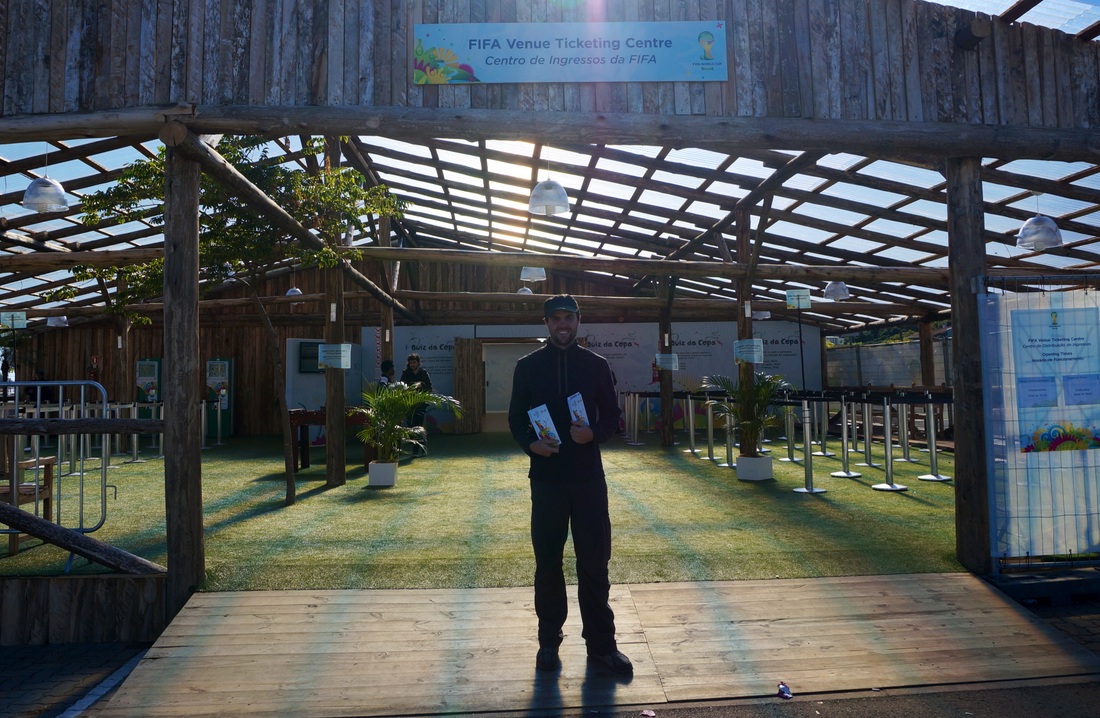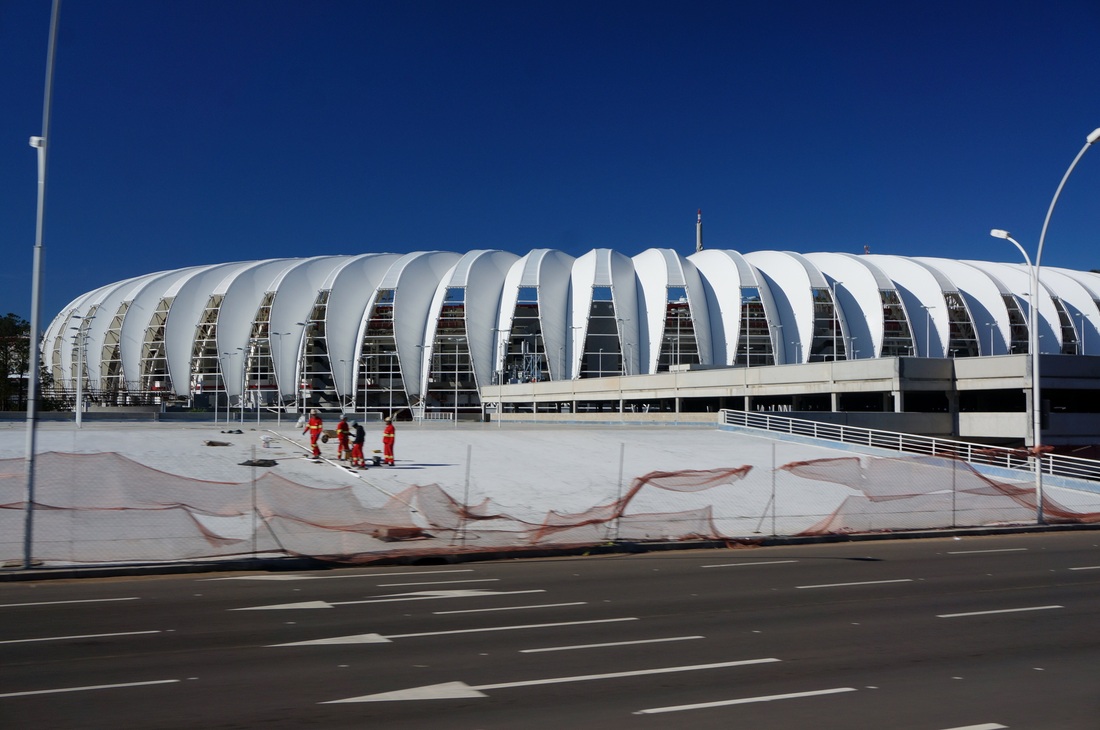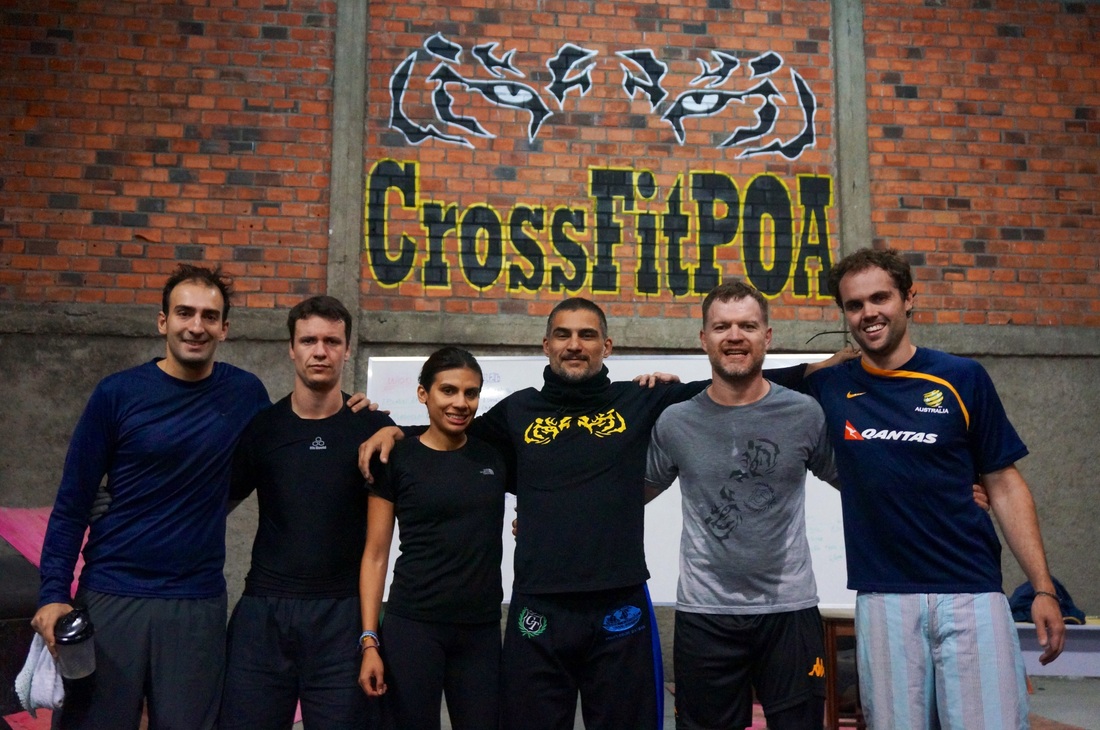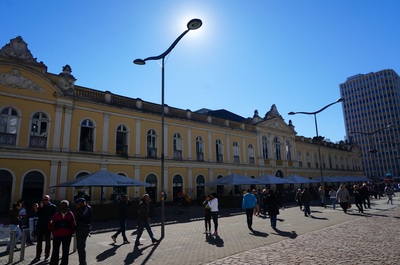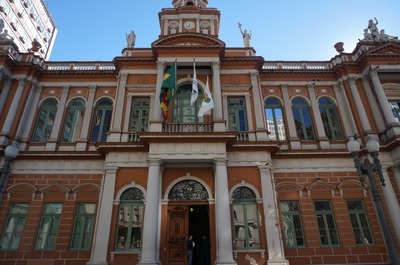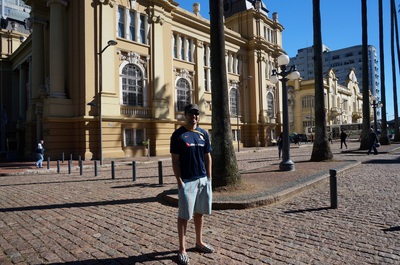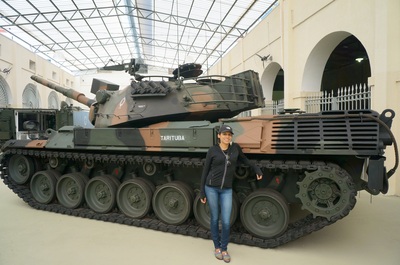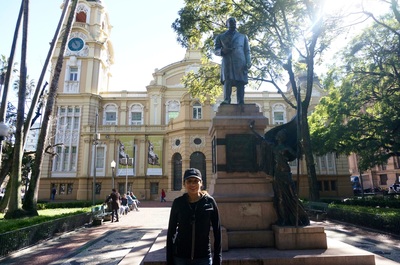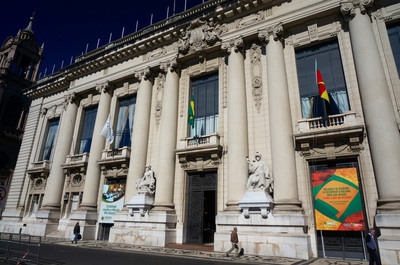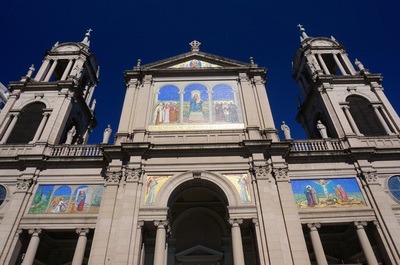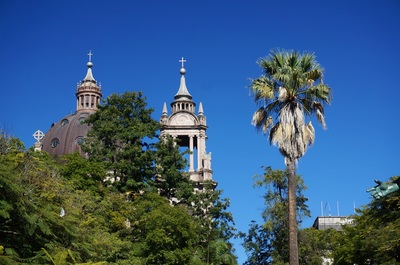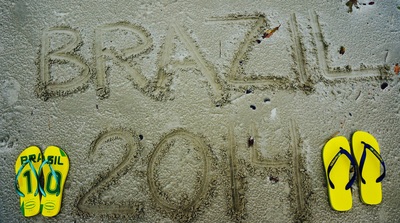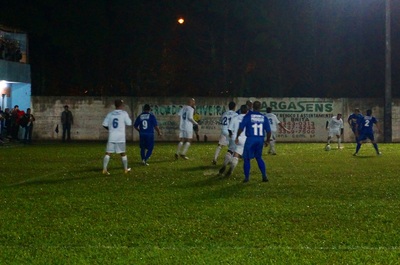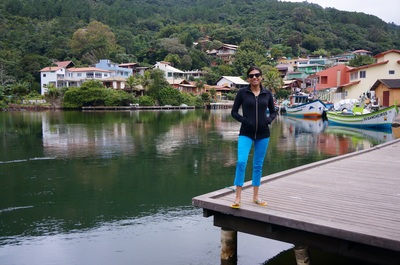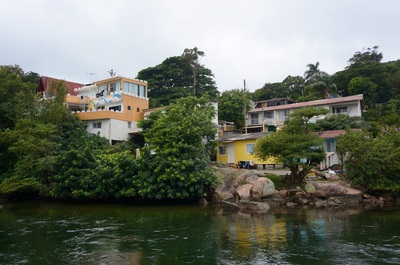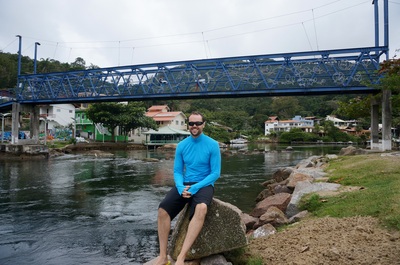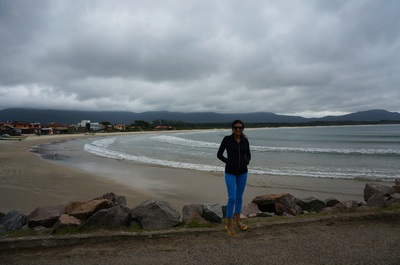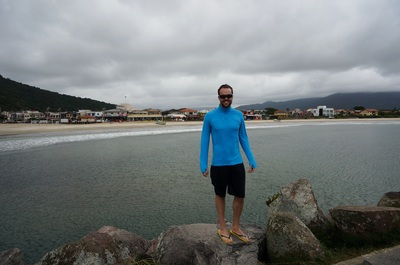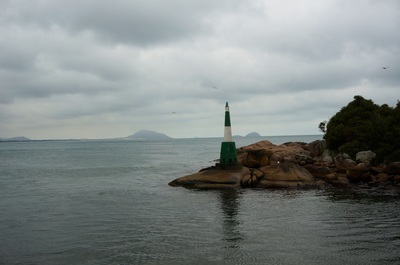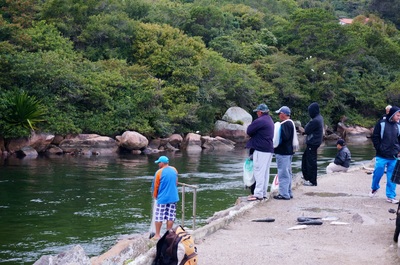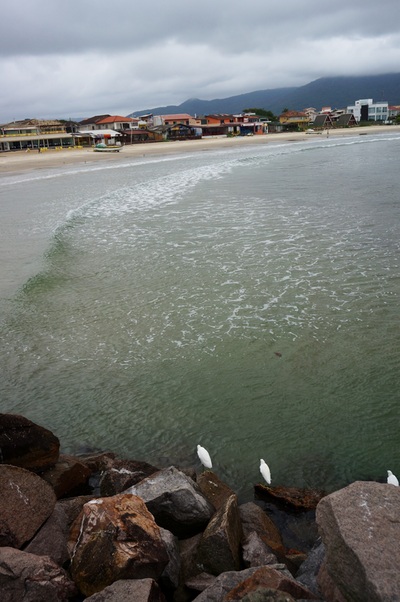This post is a big one so we’d suggest you grab your drink of choice (taking into account the time of day and whether you’re at work or not) before reading on. If you don’t have time to read the whole post right now, the video below gives you a quick four-minute summary.
Our first World Cup game was probably the one we were looking forward to the most. The game featured Argentina (v Bosnia-Herzegovina), which, of the teams with a realistic chance of winning the Cup (so excluding the US and Australia), was our favorite team. It was also the first game for the Cup at the Maracana, and was being played exactly 64 years after the iconic stadium opened. But we had to get there first...
On the morning of the game we woke up in Foz do Iguacu more than a little anxious to get to the airport and get off the ground without any delays. When we landed on time (but only four hours before kick-off) the dozens of Argentinian fans on board breathed a huge sigh of relief, and a few (including Cindy) joined an impromptu chorus of blue and white vuvuzelas.
The Argentinians weren’t the only noisy ones at the airport. The baggage carousel next to ours was surrounded by Chileans yelling their favorite, and to us it seems only, team chant - ‘Chi Chi Chi Le Le Le, Viva Chile’. Having seen Chilean fans this excited three days before their game against Spain, we weren’t too surprised to hear that 85 of them got deported after breaking into the Maracana to try to see it.
Getting off the train at Maracana station we were greeted by hundreds of desperate Argentinians offering up to four figure sums for tickets (selling tickets other than through FIFA was supposed to be highly illegal but at the games we attended we didn’t see any evidence of FIFA or the police trying at all hard to stop it). The game itself, with the exception of one beautiful Lionel Messi goal, was not all that impressive, but the atmosphere was amazing.
On the morning of the game we woke up in Foz do Iguacu more than a little anxious to get to the airport and get off the ground without any delays. When we landed on time (but only four hours before kick-off) the dozens of Argentinian fans on board breathed a huge sigh of relief, and a few (including Cindy) joined an impromptu chorus of blue and white vuvuzelas.
The Argentinians weren’t the only noisy ones at the airport. The baggage carousel next to ours was surrounded by Chileans yelling their favorite, and to us it seems only, team chant - ‘Chi Chi Chi Le Le Le, Viva Chile’. Having seen Chilean fans this excited three days before their game against Spain, we weren’t too surprised to hear that 85 of them got deported after breaking into the Maracana to try to see it.
Getting off the train at Maracana station we were greeted by hundreds of desperate Argentinians offering up to four figure sums for tickets (selling tickets other than through FIFA was supposed to be highly illegal but at the games we attended we didn’t see any evidence of FIFA or the police trying at all hard to stop it). The game itself, with the exception of one beautiful Lionel Messi goal, was not all that impressive, but the atmosphere was amazing.
We had come to the game having rote learnt the main two Argentinian chants, but a third, brand new chant, proved to be the most popular. This chant gave us our first insight as to why Brazilians really don’t like the Argentinian football team (in-fact most of the Bosnian supporters at the game were wearing Brazilian jerseys). The lyrics of the chant serve only to taunt Brazilians, asking them what it feels like to have their father in their house and insisting that Maradona was better than Pele.
After the game we caught up with Cindy’s brother and a dozen other friends in Lapa, Rio’s party district, to watch the San Antonio Spurs win the NBA title and to drink more than enough Caipiroskas to celebrate both victories. At the end of the night we caught a cab back to our hotel allowing just enough time to shower, pick up our bags and head to the airport to catch an early flight to Belo Horizonte. That morning we endured the worst hangover we’d experienced since our respective Bachelor and Bachelorette’s parties in Vegas.
After the game we caught up with Cindy’s brother and a dozen other friends in Lapa, Rio’s party district, to watch the San Antonio Spurs win the NBA title and to drink more than enough Caipiroskas to celebrate both victories. At the end of the night we caught a cab back to our hotel allowing just enough time to shower, pick up our bags and head to the airport to catch an early flight to Belo Horizonte. That morning we endured the worst hangover we’d experienced since our respective Bachelor and Bachelorette’s parties in Vegas.
On the plane we both had a look on our face that read, to quote die hard, we’re too old for this sh*t! The most embarrassing part was that in Belo Horizonte we were staying with the family of a close friend (Lucas), and they were waiting for our increasingly tardy plane at the airport - not a great first impression! Thankfully our hosts were really understanding, leaving us to sleep all afternoon.
We awoke to hear that Lucas wouldn’t be joining us in Brazil because he couldn't find his passport. This meant that his auntie, Tanya, had been left to play host, for about a week in total, to two strangers who didn’t speak her language. Thankfully Tanya and her family, particularly her Son, Breno, and daughter, Bianca, did everything they could to make us feel welcome and ensure we made the best of our time in Belo Horizonte. We were able to break down the language barrier
thanks to regular contact with Breno’s cousin, Ron, and girlfriend, Aline, who both spoke English. Cindy was also able to communicate directly with Tanya by speaking Spanish slowly with her best attempt at a Portugese accent.
We spent our first night in Belo Horizonch (as the locals pronounce it) at a sports bar to watch the US ultimately, but not convincingly, beat Ghana. Just as we had the night before we ordered plenty of drinks, but this time all of them were water. The next day we woke up feeling much better, and ready to attend our second game, Belgium v Algeria, at the Mineiro. Aline’s family owns a restaurant really close to the stadium, so for this and each of our three games at the Mineiro
we went to the restaurant before and after the game.
We awoke to hear that Lucas wouldn’t be joining us in Brazil because he couldn't find his passport. This meant that his auntie, Tanya, had been left to play host, for about a week in total, to two strangers who didn’t speak her language. Thankfully Tanya and her family, particularly her Son, Breno, and daughter, Bianca, did everything they could to make us feel welcome and ensure we made the best of our time in Belo Horizonte. We were able to break down the language barrier
thanks to regular contact with Breno’s cousin, Ron, and girlfriend, Aline, who both spoke English. Cindy was also able to communicate directly with Tanya by speaking Spanish slowly with her best attempt at a Portugese accent.
We spent our first night in Belo Horizonch (as the locals pronounce it) at a sports bar to watch the US ultimately, but not convincingly, beat Ghana. Just as we had the night before we ordered plenty of drinks, but this time all of them were water. The next day we woke up feeling much better, and ready to attend our second game, Belgium v Algeria, at the Mineiro. Aline’s family owns a restaurant really close to the stadium, so for this and each of our three games at the Mineiro
we went to the restaurant before and after the game.
Leading into the World Cup there was a lot of talk about Belgium being the dark horse to win the Cup, since this year it featured a golden generation of stars who play at many of the best European clubs. Unfortunately, the Belgians didn’t look all that impressive despite getting the win they needed. Even so, the atmosphere was again fantastic, with plenty of Belgians and a surprisingly large amount of Algerians there to support their teams.
After the final whistle, the stadium emptied in no time, as all eyes turned to the Brazil v Mexico game starting one hour later. We watched most of that game at Bianca’s house, sitting on a rooftop terrace, seeing the sun set over urban Belo Horizonte and enjoying her husband’s Brazilian barbeque. Just as well the setting was so memorable because the game itself was far from it, ending goalies and leaving many Brazilians almost ready to write their team off as genuine World Cup contenders.
After the final whistle, the stadium emptied in no time, as all eyes turned to the Brazil v Mexico game starting one hour later. We watched most of that game at Bianca’s house, sitting on a rooftop terrace, seeing the sun set over urban Belo Horizonte and enjoying her husband’s Brazilian barbeque. Just as well the setting was so memorable because the game itself was far from it, ending goalies and leaving many Brazilians almost ready to write their team off as genuine World Cup contenders.
The next morning we flew to Sao Paulo for a short three-day trip. We had heard plenty of people tell us that Sao Paulo isn’t worth a visit, but we decided to go anyway so we could reach our own conclusion. That conclusion, in short, is that there really is very little to see in Sao Paulo, despite the fact that it is the most populous city in the Southern Hemisphere and the financial hub of South America. Very little, but not nothing.
Like a lot of large South American cities, Sao Paulo has plenty of nice buildings in its historical centre, which is where we stayed. As young professionals we were more interested in the more modern, commercial, part of Sao Paulo, so we took a walking tour through Paulista Avenue. We saw some impressive architecture (in particular the MASP museum), ate some really nice (but expensive) Brazilian and international food, and visited the Bohemian bar district of Villa Madalena to watch Colombia beat Ivory Coast. We spent the rest of our time in the FIFA Fan Fest, with the highlight being Tim Cahill’s goal of the tournament in Australia’s impressive loss to the Netherlands.
Like a lot of large South American cities, Sao Paulo has plenty of nice buildings in its historical centre, which is where we stayed. As young professionals we were more interested in the more modern, commercial, part of Sao Paulo, so we took a walking tour through Paulista Avenue. We saw some impressive architecture (in particular the MASP museum), ate some really nice (but expensive) Brazilian and international food, and visited the Bohemian bar district of Villa Madalena to watch Colombia beat Ivory Coast. We spent the rest of our time in the FIFA Fan Fest, with the highlight being Tim Cahill’s goal of the tournament in Australia’s impressive loss to the Netherlands.
We returned to Belo Horizonte the night before our third game, Argentina v Iran. Our plane was full of Argentina fans and when we touched down we all chanted ‘Vamos Vamos Argentina, Vamos Vamos a ganar…’. On the way to the game the next day we were even able to get Breno, a staunch Brazil supporter, to learn the chant and become an Argentina fan for the day.
The atmosphere at the game was the most impressive of the seven games we attended. For ninety minutes neither side was able to open the scoring and the Argentinian fans responded by chanting louder and louder. In injury time the stadium erupted when Lionel Messi slotted a beautiful left footer in the corner of the net. Celebrations were still in full force half an hour after the game finished when we heard the first and only announcement in Spanish at the World Cup, a
reminder to the Argentinians that the game was over accompanied with an invitation for them to go home.
The atmosphere at the game was the most impressive of the seven games we attended. For ninety minutes neither side was able to open the scoring and the Argentinian fans responded by chanting louder and louder. In injury time the stadium erupted when Lionel Messi slotted a beautiful left footer in the corner of the net. Celebrations were still in full force half an hour after the game finished when we heard the first and only announcement in Spanish at the World Cup, a
reminder to the Argentinians that the game was over accompanied with an invitation for them to go home.
A few hours after the game we boarded an overnight bus to Rio de Janiero, arriving on the morning of our fourth game, Belgium v Russia at the Maracana. This game was the most disappointing of the games we saw, with a standard of play that would be familiar to people who regularly watch US and Australian domestic league games. When one fan was caught on the big screen sleeping nobody was surprised. The only redeeming features were that we were able to see the game with Cindy’s brother, Napo, and Belgium finally managed to score a goal late in the
second half. With Russia hosting the next World Cup and Qatar the one after, it looks like Brazil will be the last host country for at least a decade that will play more than three games in their home
tournament.
second half. With Russia hosting the next World Cup and Qatar the one after, it looks like Brazil will be the last host country for at least a decade that will play more than three games in their home
tournament.
After the game we headed to Copacabana to catch up with a couple of our friends from Australia, Varun and Ish, for dinner. We then met up with half a dozen American friends, including Napo, to watch the US v Portugal game from a packed Fifa Fan Fest on Copacabana beach. The setting was really special, with a crowd largely consisting of patriotic Americans and Brazilians loyal to their mother country. Unfortunately, a goal set up by our least favorite player, Christiano Ronaldo, in the last minute of extra time meant the US was denied the win. To drown our sorrows we migrated to the Bacardi bar next to the beach to get stuck into some very large mojitos. At two in the morning we convinced a local to lend us his soccer ball so we could play a short game on the beach. What started as four on four (Aussies v Americans) quickly became fifteen on fifteen as people came from the beach, bars and boardwalk to join us. Two local kids no more than 12 years old ended up stealing the show with a far superior mix of skill, athleticism and sobriety.
The next day we slept in, did some shopping at the iPanema markets and had lunch with Napo before catching a bus back to Belo Horizonte, arriving the night before our fifth game, England v Costa Rica. At that stage, Costa Rica had already beaten two previous World Cup winners in its group (Italy and Uruguay) and needed only a draw against a third, the Poms, to advance as the most unlikely of group winners. On the way to the game we watched a motorcade come past transporting a very famous royal football fan (hint: this time he had clothes on). The result was the nil all draw that Costa Rica seemed to be playing for, which at least allowed England to leave yet another disappointing World Cup with a single point. Even so, there was still plenty of energy in the stadium, with the defiantly loud Brits only just drowned out by a chorus of Costa Ricans and Brazilians singing 'Ole Ole Ole, Ticos, Ticos’.
Following the game we headed back to Aline’s family’s restaurant to see replays of Luis Suarez inexplicably biting an opposition player…again! Just as ugly was the attitude of some British fans also sitting at the restaurant. They had turned up to the game dressed as flashy knights knowing that their team had already been eliminated, but when after the game a local wanted to take a photo with them (remember that people from Belo don’t see foreigners very often, let alone foreigners dressed up like that) they knocked over beer bottles on their way to shoving the camera away. You’d think that after so many poor World Cup performances in the last 50 years, the Brits would have gotten better at losing.
After saying goodbye and a thousand (but probably not enough) thank yous to Tanya and her extended family, we flew to Brasilia for our final two Wolrd Cup games. The first of these games was Portugal v Ghana, featuring Christiano Ronaldo, one of the most talented and least popular players in world football. There was some added excitement for us in this game because in a lot of ways it had more bearing on whether the US advanced to the next round than the US v Germany game that was being played at the same time. The formula was quite complicated, but essentially we wanted either a draw or a narrow Portugal win. When Portugal scored first, we started cheering the Ghanaians, but switched allegiances again after Ghana equalized. The 2-1 Portugal win combined with a 1-0 US loss was good enough, and when the final whistle blew the loudest cheers you could hear at the National Stadium in Brasilia were ‘USA, USA…’. During the game, Ronaldo did nothing to improve our very negative view of him, sulking around for ten minutes like a six year old boy because a teammate didn’t pass him the ball.
After saying goodbye and a thousand (but probably not enough) thank yous to Tanya and her extended family, we flew to Brasilia for our final two Wolrd Cup games. The first of these games was Portugal v Ghana, featuring Christiano Ronaldo, one of the most talented and least popular players in world football. There was some added excitement for us in this game because in a lot of ways it had more bearing on whether the US advanced to the next round than the US v Germany game that was being played at the same time. The formula was quite complicated, but essentially we wanted either a draw or a narrow Portugal win. When Portugal scored first, we started cheering the Ghanaians, but switched allegiances again after Ghana equalized. The 2-1 Portugal win combined with a 1-0 US loss was good enough, and when the final whistle blew the loudest cheers you could hear at the National Stadium in Brasilia were ‘USA, USA…’. During the game, Ronaldo did nothing to improve our very negative view of him, sulking around for ten minutes like a six year old boy because a teammate didn’t pass him the ball.
Our second Brasilia game was a few days later, so in the interim we did some sightseeing and spent some more time with our Aussie friends, Varun and Ish. We realized pretty quickly that Brasilia - the capital of Brazil that was created from scratch in just three years in an effort to encourage Brazilians to move inland rather than concentrating in southern coastal cities - is a very unusual place. It features some beautiful architecture that, in the 1960s would have looked futuristic, but in 2014 looks a little retro (but not in a tacky way). When the city was planned and built in the late 1950s, planes and cars were all the rage, so it was designed in the shape of a large airplane and it is a nightmare for pedestrians. The soil is a deep red that left us constantly wanting to wash our feet, and made us wonder how they manage to grow any fauna at all in the area.
Brasilia is also unusual in that almost all of the locals live a long way away from the planned centre of the city, which is mostly reserved for hotels and government buildings. The Fifa fan fest was initially proposed to be put in the hotel district, but was moved closer to the locals (presumably for political reasons), so to watch the Brazil v Chile round of 16 game we had to catch a train for half an hour and walk an hour (in total) to get there. The locals’ outpouring of excitement (and relief) when the Brazilians finally won the game in penalties was one of our more memorable World Cup experiences. With hindsight though, you have to wonder whether a round of 16 loss to Chile in penalties would have been less demoralizing than the semi final annihilation at the hands of Germany that followed a week later.
Our final World Cup game was France against Nigeria, which admittedly was one of the least interesting round of 16 games but that’s the luck of the draw (if results had panned out differently, we might have seen Argentina play Switzerland). Even so, we were still thankful to be able to attend the Estadio Nacional - which we’d rate, together with the MCG in Melbourne, as our equal favorite stadium in the World - one more time to see a relatively free flowing game. After watching the last two round of 16 games (an Argentina win and a US loss, both in extra time) from various Brasilia bars, we headed to the airport, a little stunned that our month in Brazil, which we’d looked forward to for such a long time, had come to an end.
Before we finish our blog, we wanted to address one frequently asked question - was Brazil really as disorganized and dangerous as it was made out to be in the lead up to the Cup? Certainly there was plenty of evidence that Brazil could have been more organized, however mostly this didn’t impact our experience. The thing to remember is that Fifa doesn’t just expect a host country to produce one stadium, two goals and a football - Brazil, as with any other host, was expected to
produce 12 new (or significantly remodeled) stadiums (we think 8 would be plenty and would have avoided some of the most passionate protests around this World Cup in particular, but lets not get into that). Host countries are also expected to produce a huge amount of broader new
infrastructure, including public transport, hotels, fan zones, media hubs etc etc.
In Brazil, the important stuff was ready enough in time for the Cup and nobody really missed the stuff that wasn’t ready. For example, I’m sure Fifa would have liked to see colorful sign-posts telling tourists how to get to the Fan Fest in Brasilia, but the black and white printed A4 piece of paper stuck lopsidedly to the metro station wall did the job. Seeing how slowly Brazilians work (for example we spent an astounding one hour in a Brasilia airport baggage drop queue less than 8 meters long), it’s a wonder that they got anything done at all!
On the security question, we’re perhaps not the best judges since we spent most of our time in the safer parts of the safer (southern) cities, and had recently visited relatively more dangerous places like Bolivia. The security warnings were really directed at western tourists who were under the erroneous assumption that Brazil is as safe as home (so not us). The reality is that there is a lot of crime in Brazil and they don’t have enough police to get the problem fully under control. Even if you’re lucky enough to see a policemen driving through a suburban street their lights will inevitably be flashing; we’re told the intention is to tell criminals to wait until they have left the area before committing a crime. During the Cup there were plenty of extra police around the stadiums and Fan Fests, but we’d often see 20 of them standing together talking and then not encounter another for a kilometer or two.
In the end, we thoroughly enjoyed being able to see a World Cup in the spiritual home of football - a true once in a lifetime experience. Although we were sad that it was over, we flew to Colombia knowing that we still had plenty to look forward to in our backpacking adventures.
produce 12 new (or significantly remodeled) stadiums (we think 8 would be plenty and would have avoided some of the most passionate protests around this World Cup in particular, but lets not get into that). Host countries are also expected to produce a huge amount of broader new
infrastructure, including public transport, hotels, fan zones, media hubs etc etc.
In Brazil, the important stuff was ready enough in time for the Cup and nobody really missed the stuff that wasn’t ready. For example, I’m sure Fifa would have liked to see colorful sign-posts telling tourists how to get to the Fan Fest in Brasilia, but the black and white printed A4 piece of paper stuck lopsidedly to the metro station wall did the job. Seeing how slowly Brazilians work (for example we spent an astounding one hour in a Brasilia airport baggage drop queue less than 8 meters long), it’s a wonder that they got anything done at all!
On the security question, we’re perhaps not the best judges since we spent most of our time in the safer parts of the safer (southern) cities, and had recently visited relatively more dangerous places like Bolivia. The security warnings were really directed at western tourists who were under the erroneous assumption that Brazil is as safe as home (so not us). The reality is that there is a lot of crime in Brazil and they don’t have enough police to get the problem fully under control. Even if you’re lucky enough to see a policemen driving through a suburban street their lights will inevitably be flashing; we’re told the intention is to tell criminals to wait until they have left the area before committing a crime. During the Cup there were plenty of extra police around the stadiums and Fan Fests, but we’d often see 20 of them standing together talking and then not encounter another for a kilometer or two.
In the end, we thoroughly enjoyed being able to see a World Cup in the spiritual home of football - a true once in a lifetime experience. Although we were sad that it was over, we flew to Colombia knowing that we still had plenty to look forward to in our backpacking adventures.
